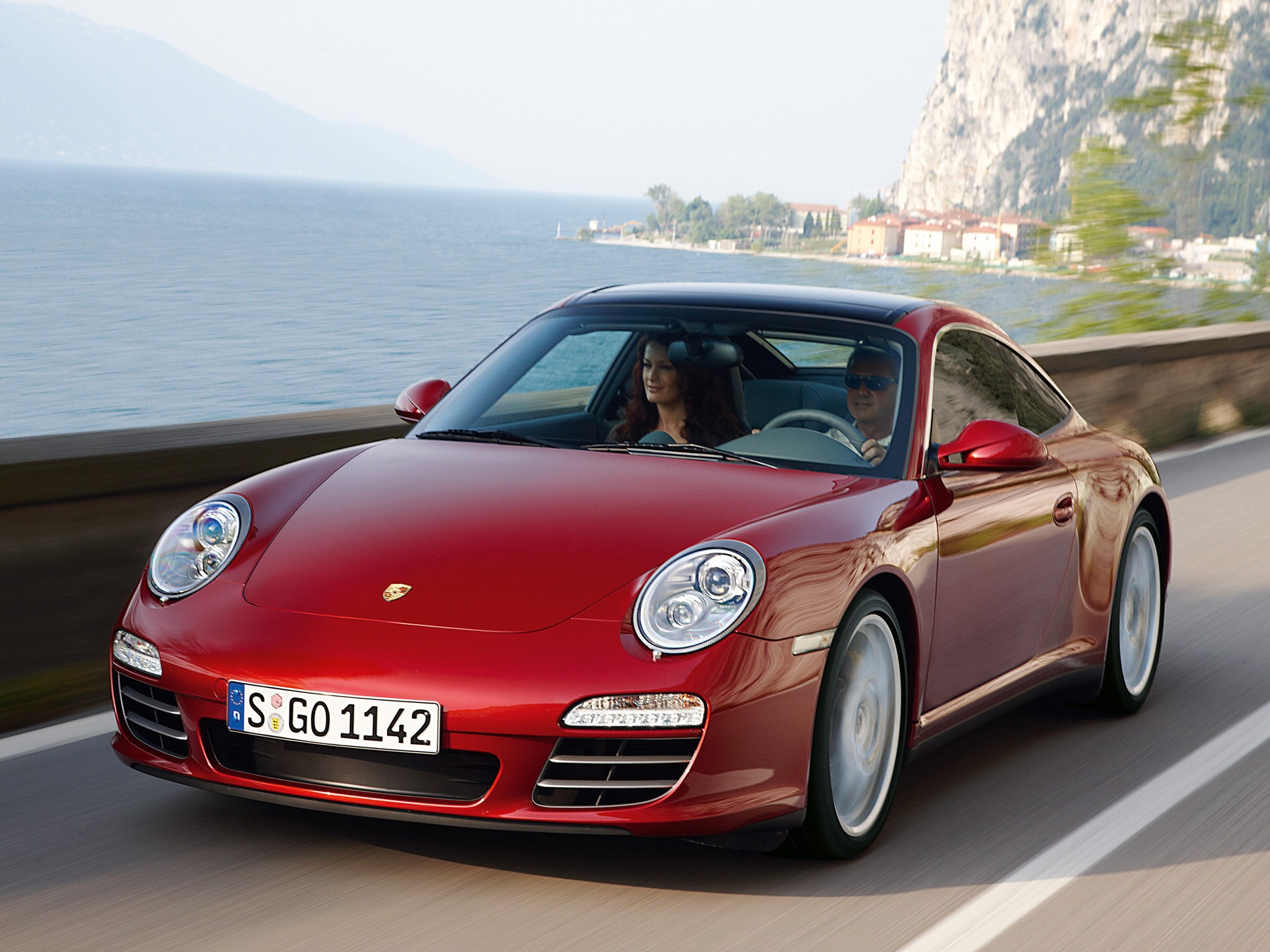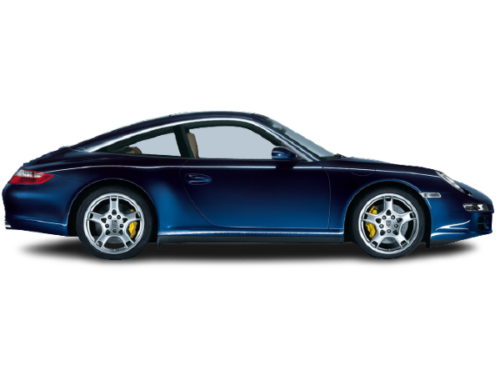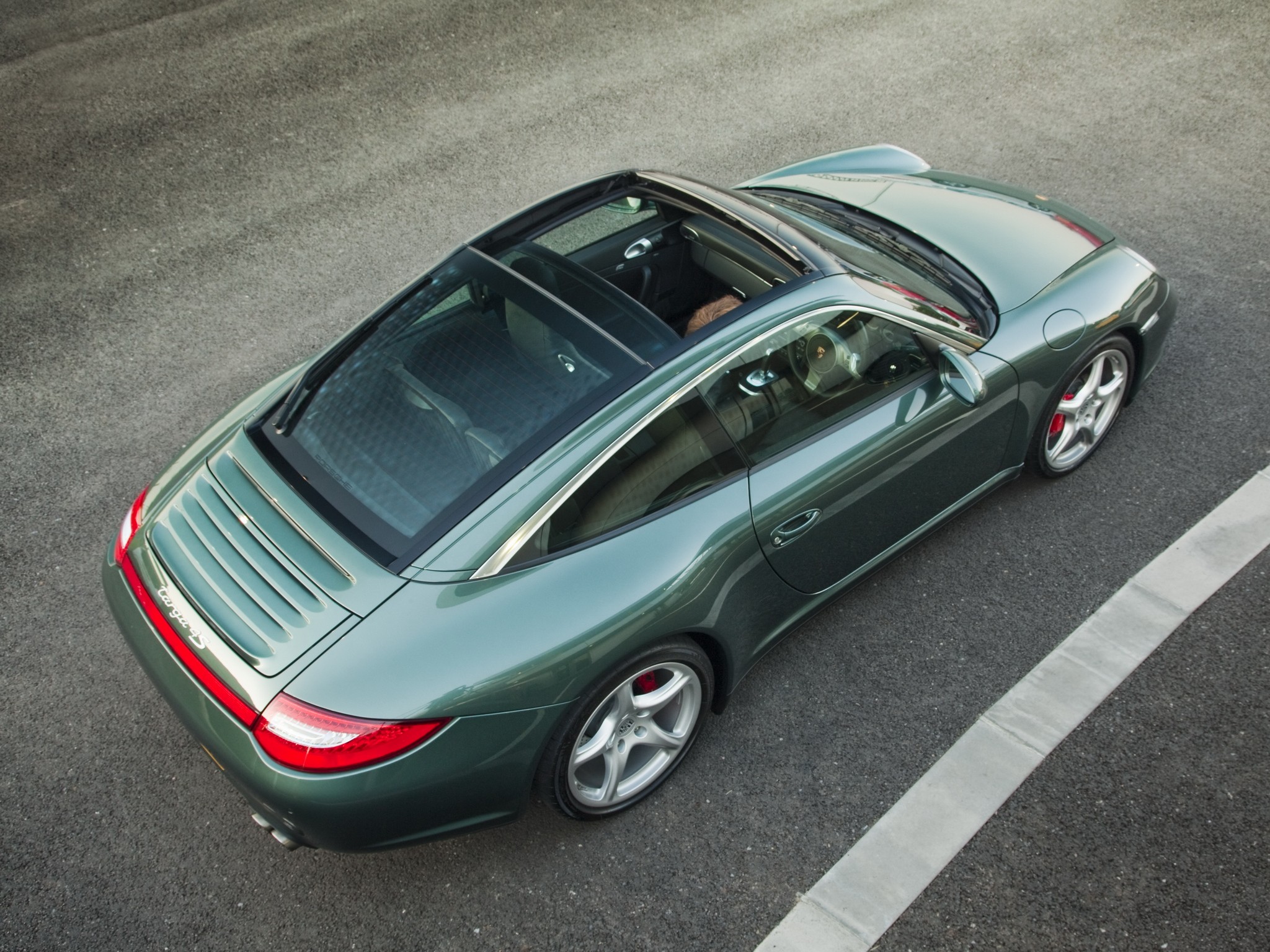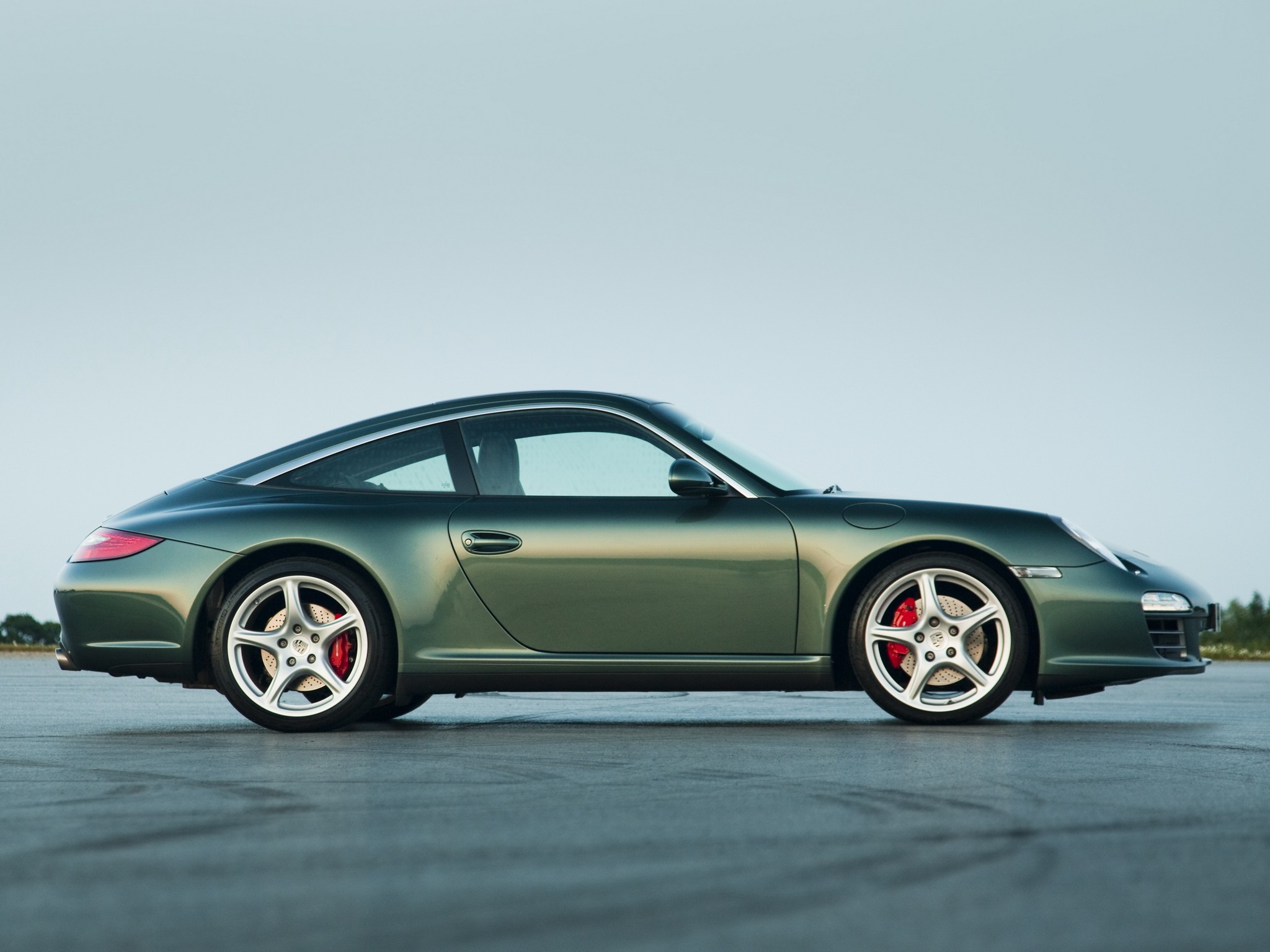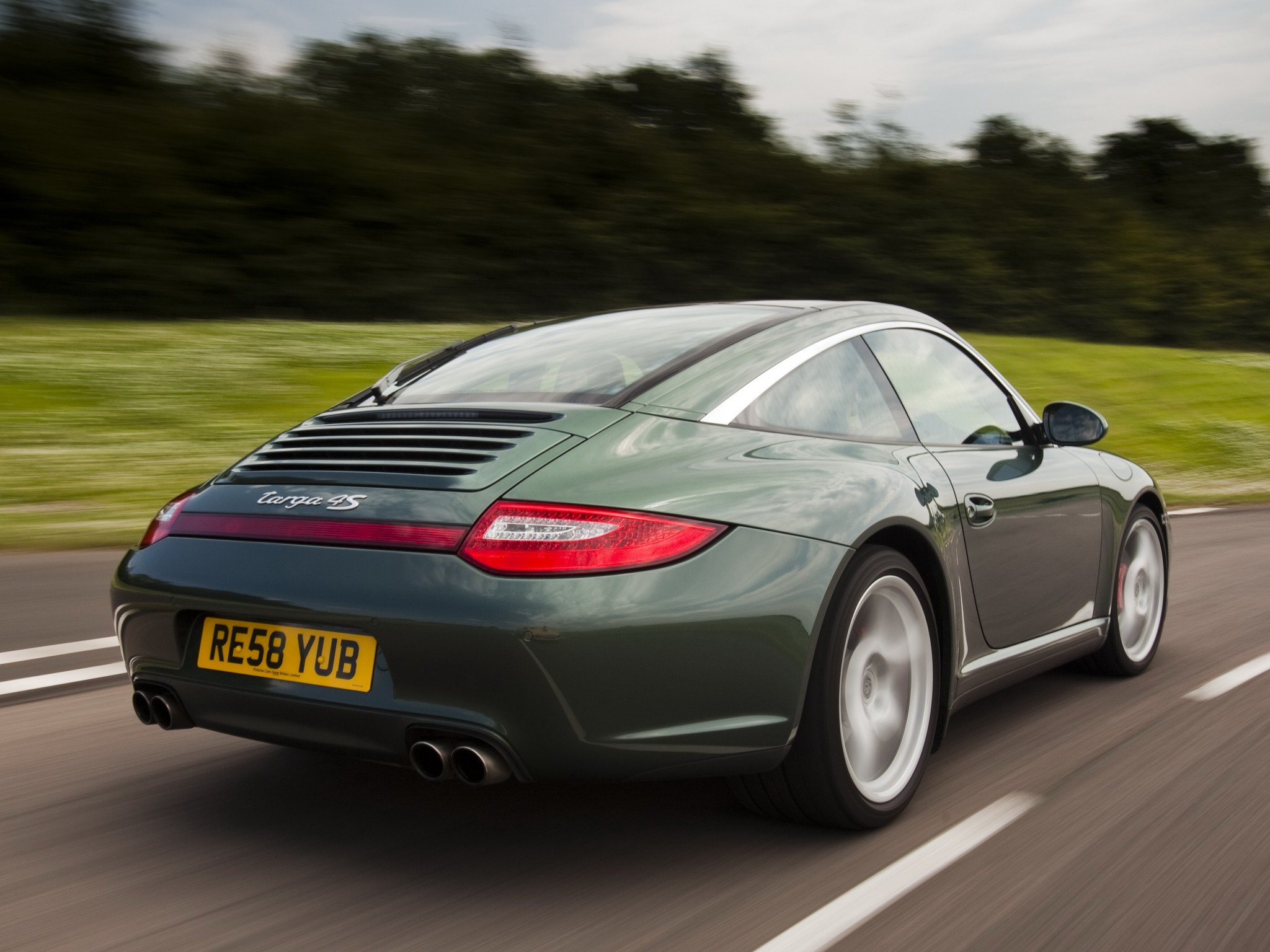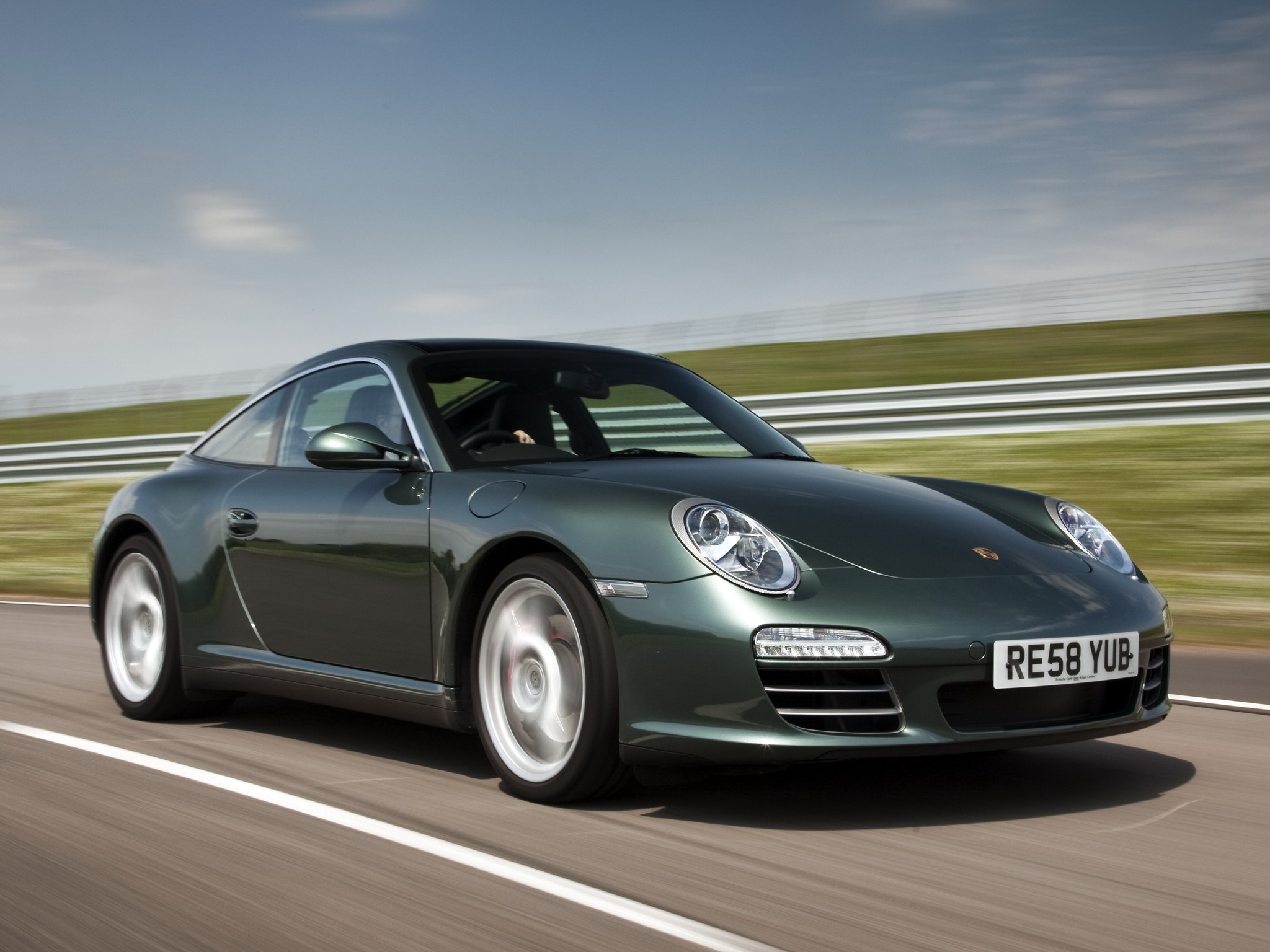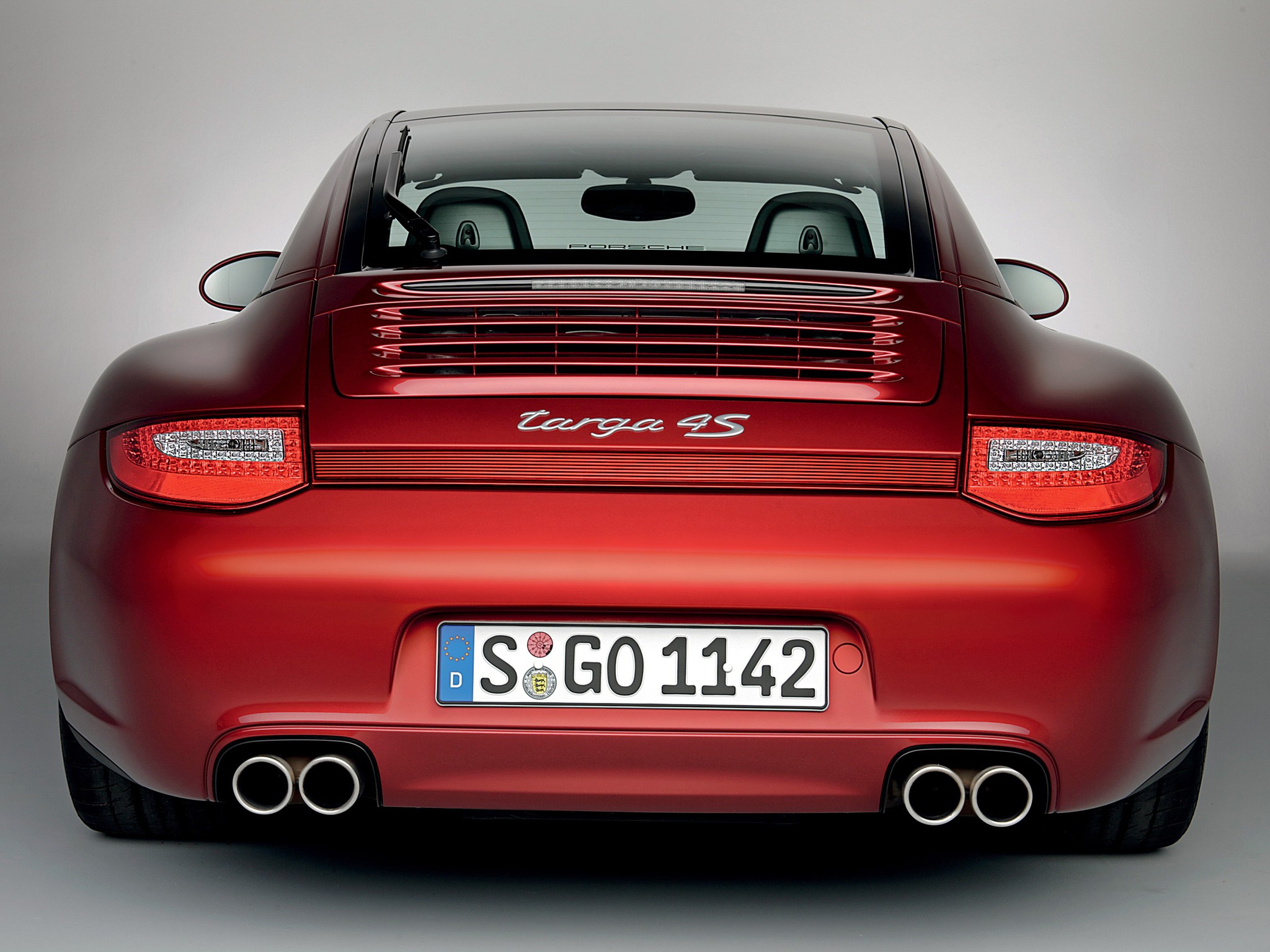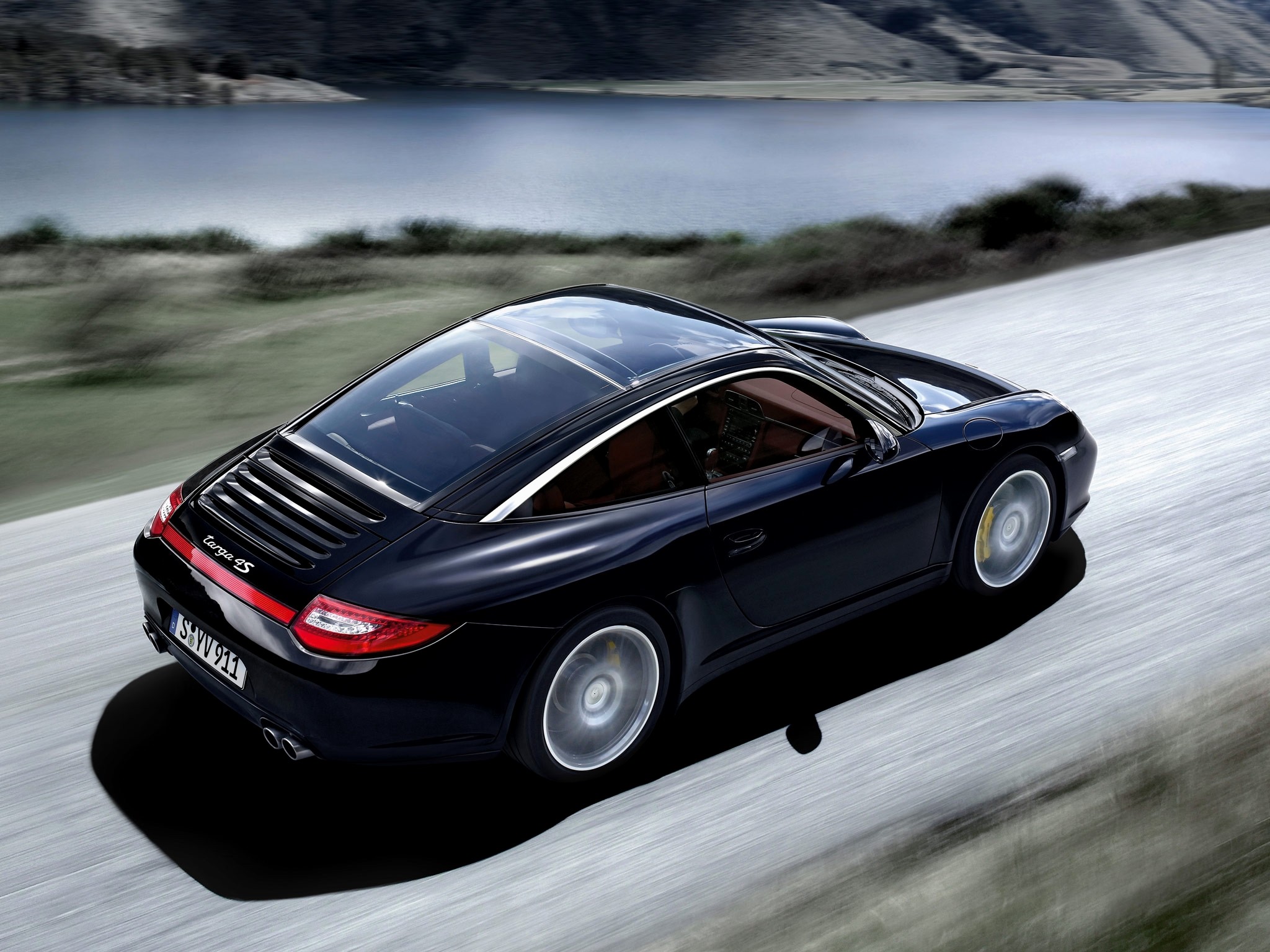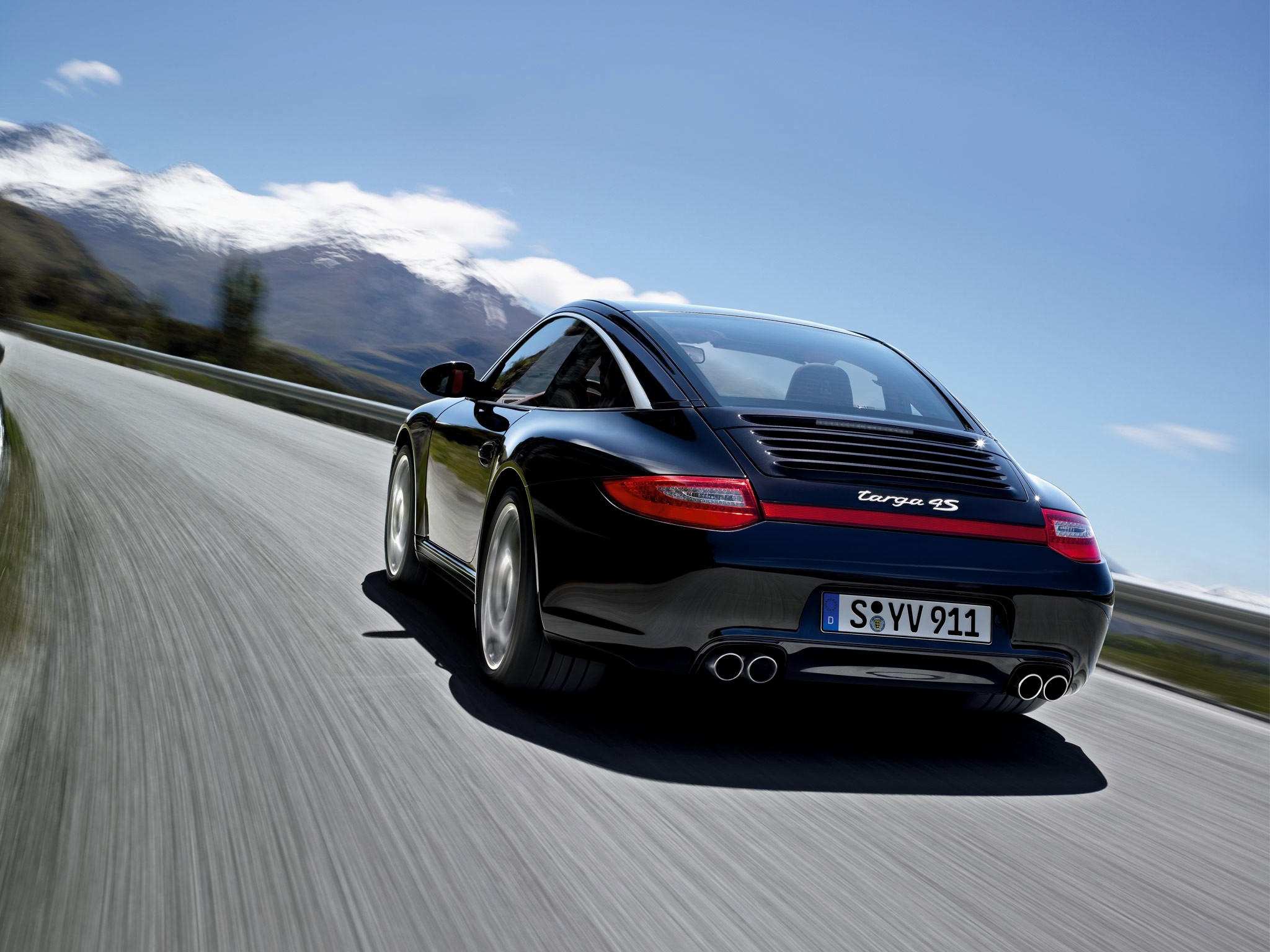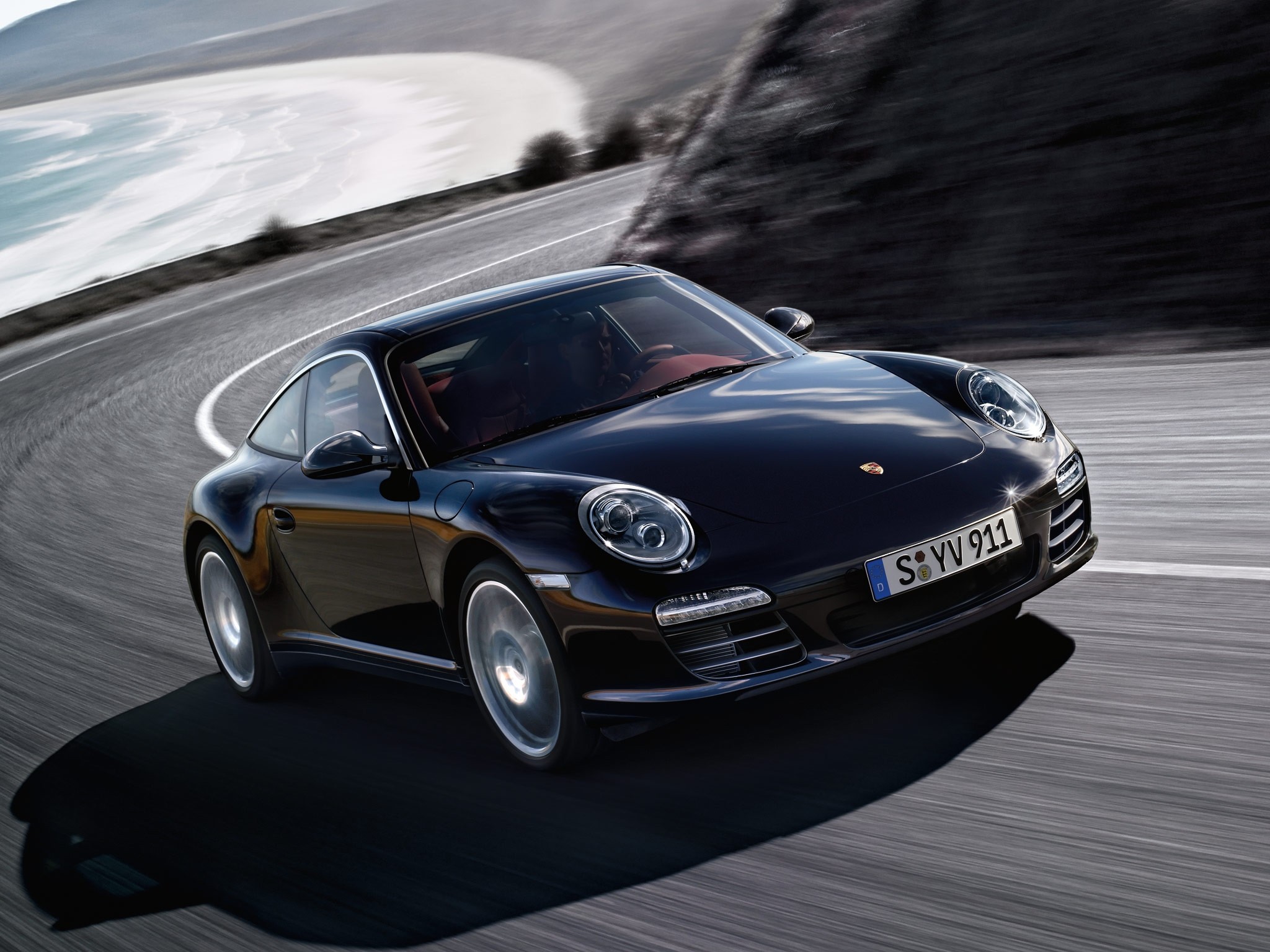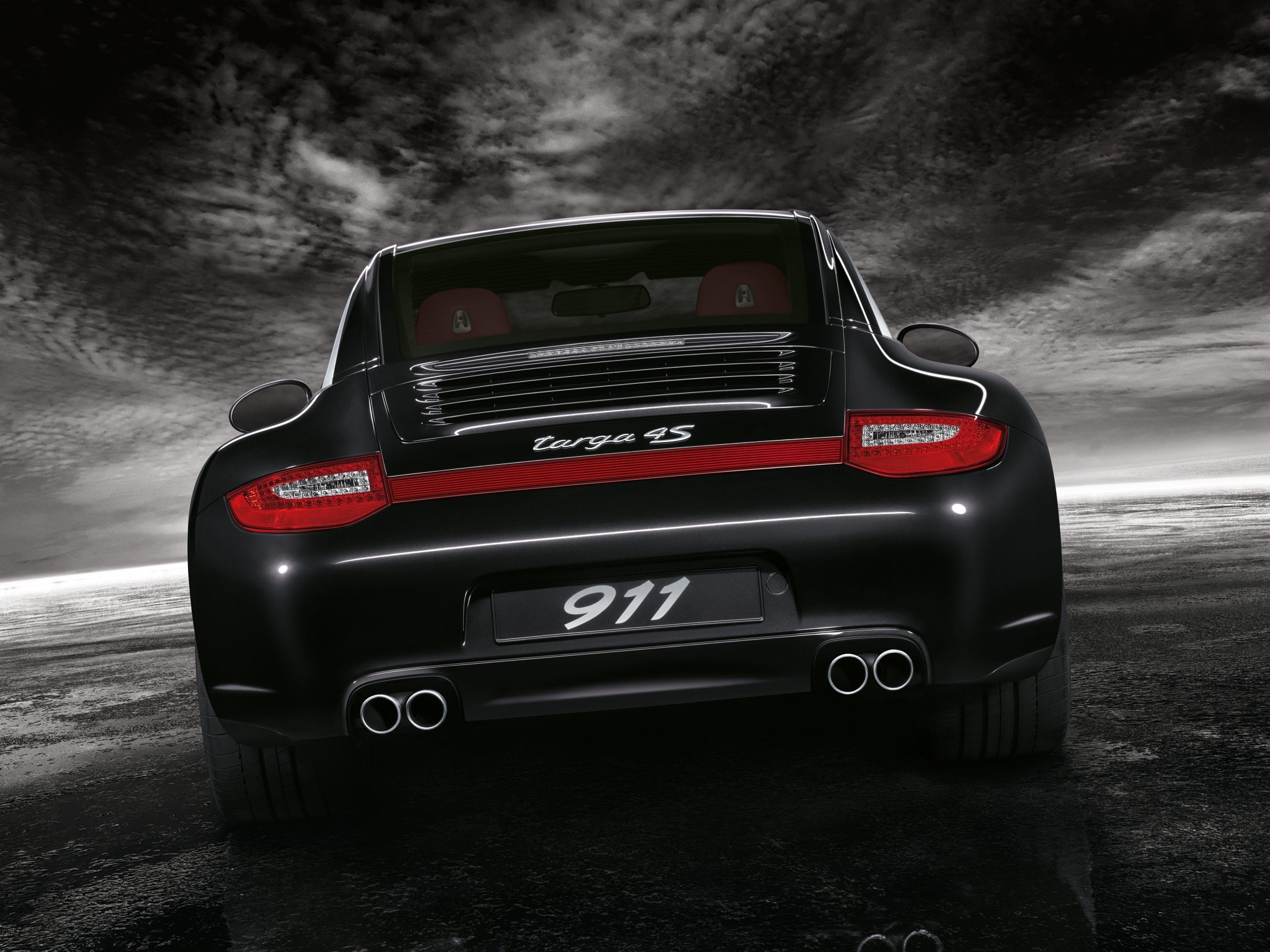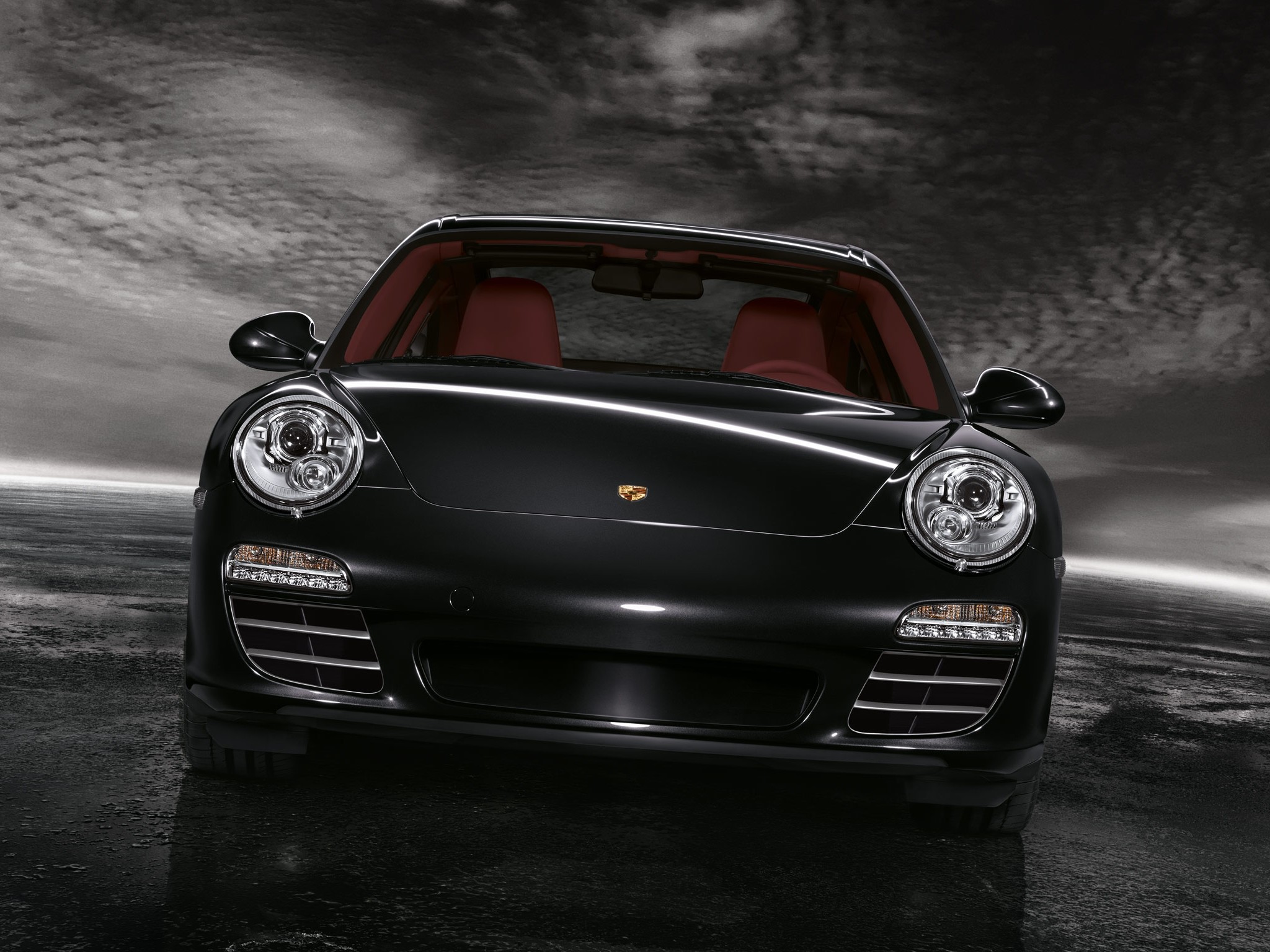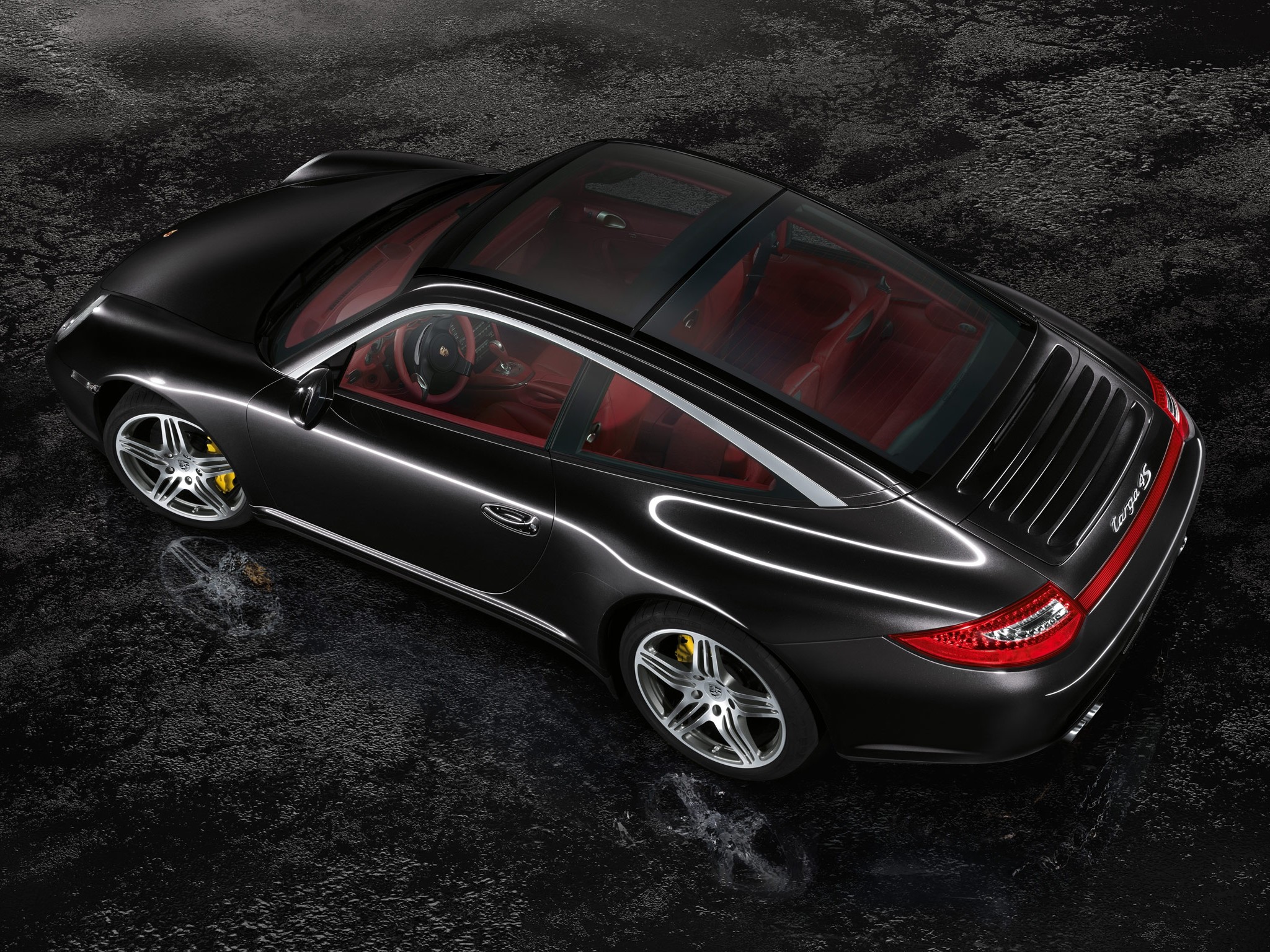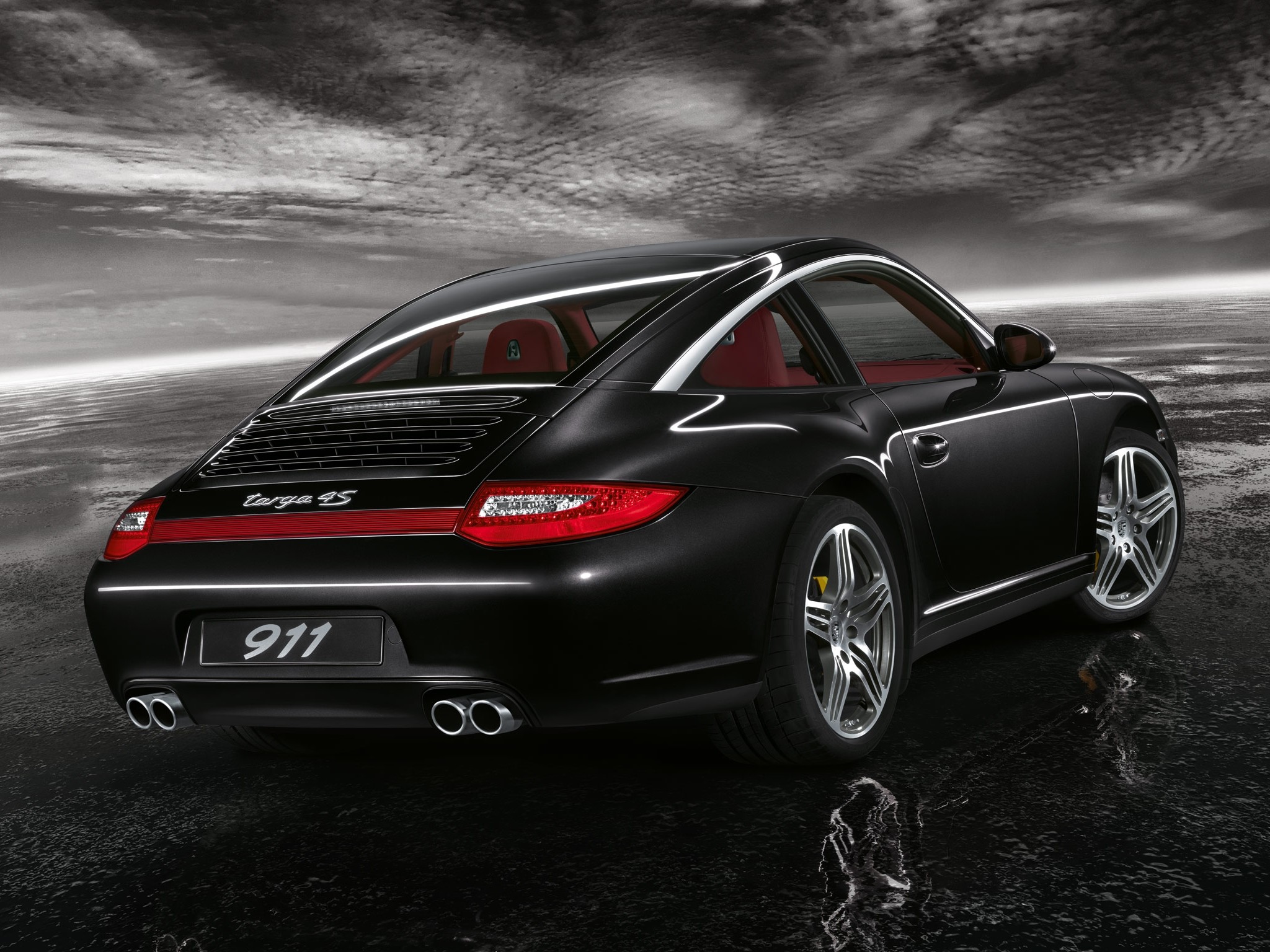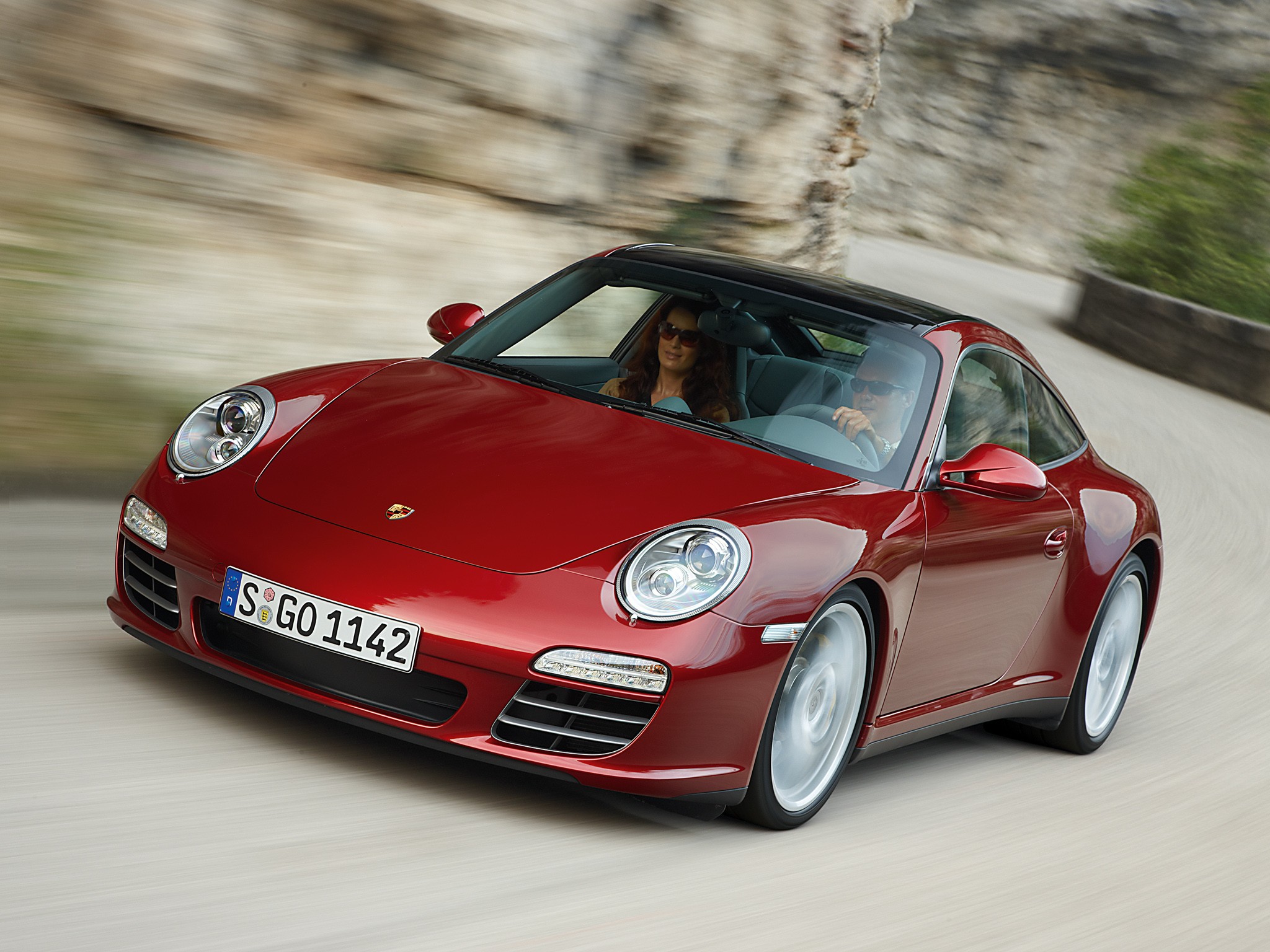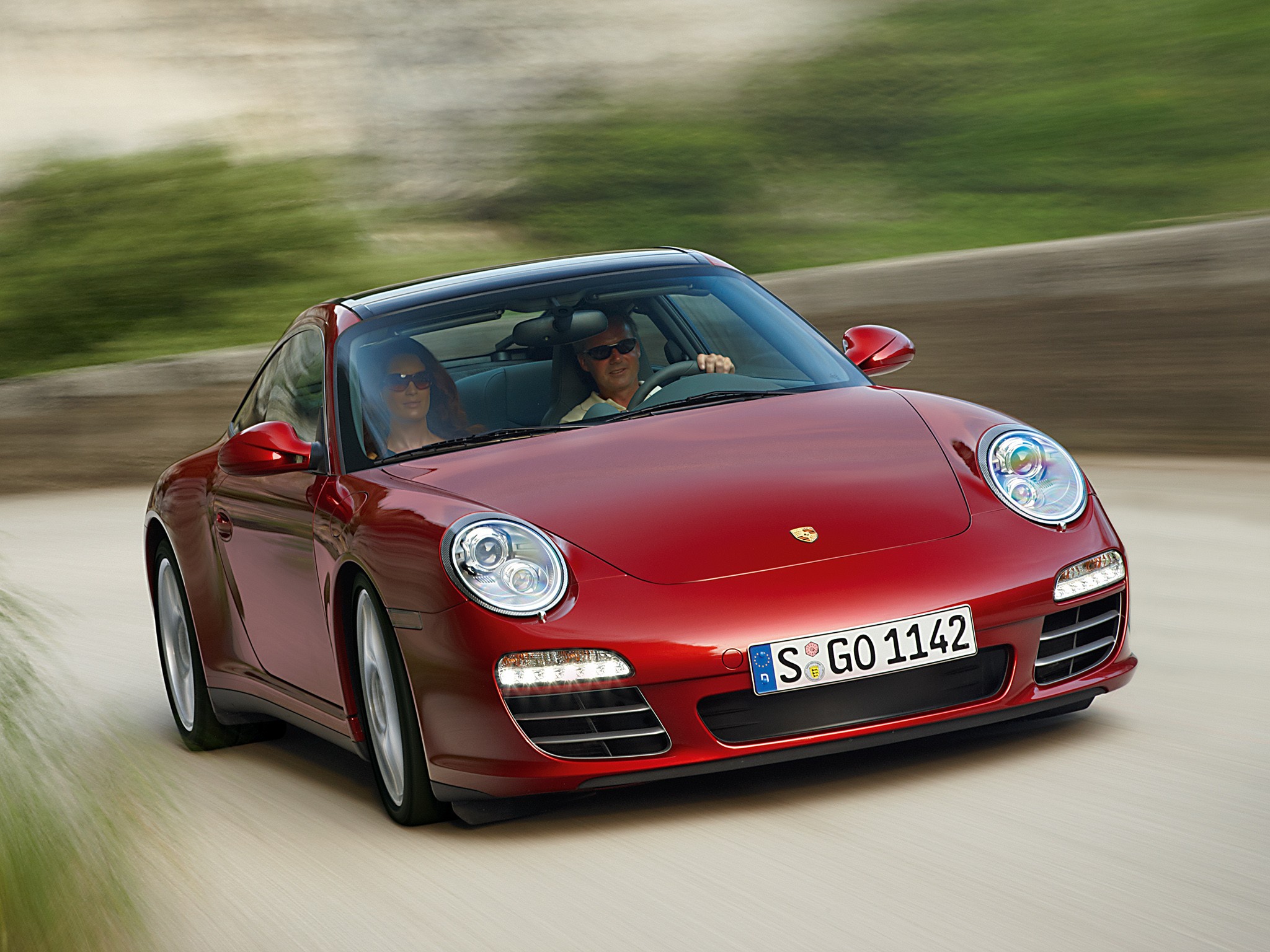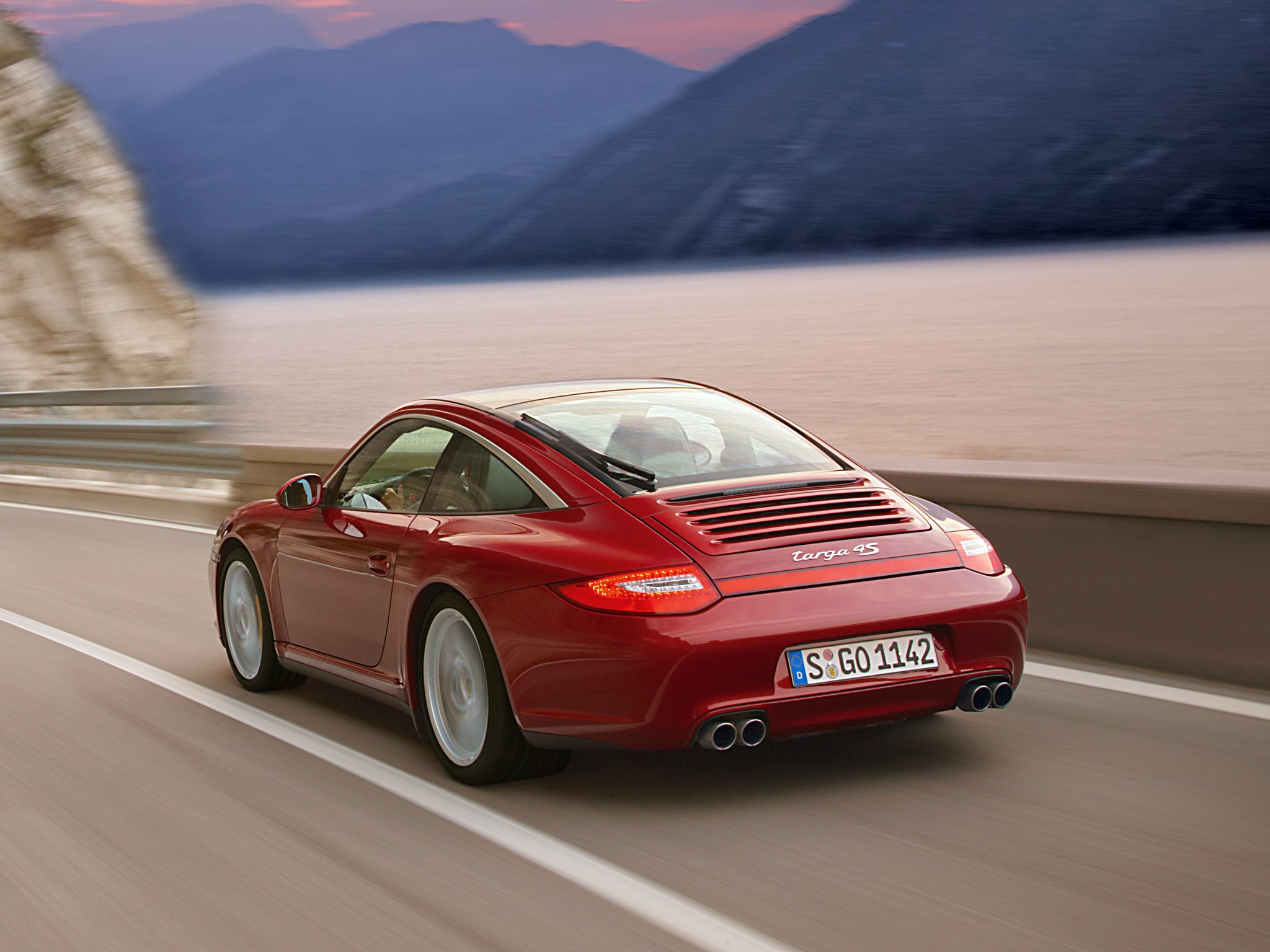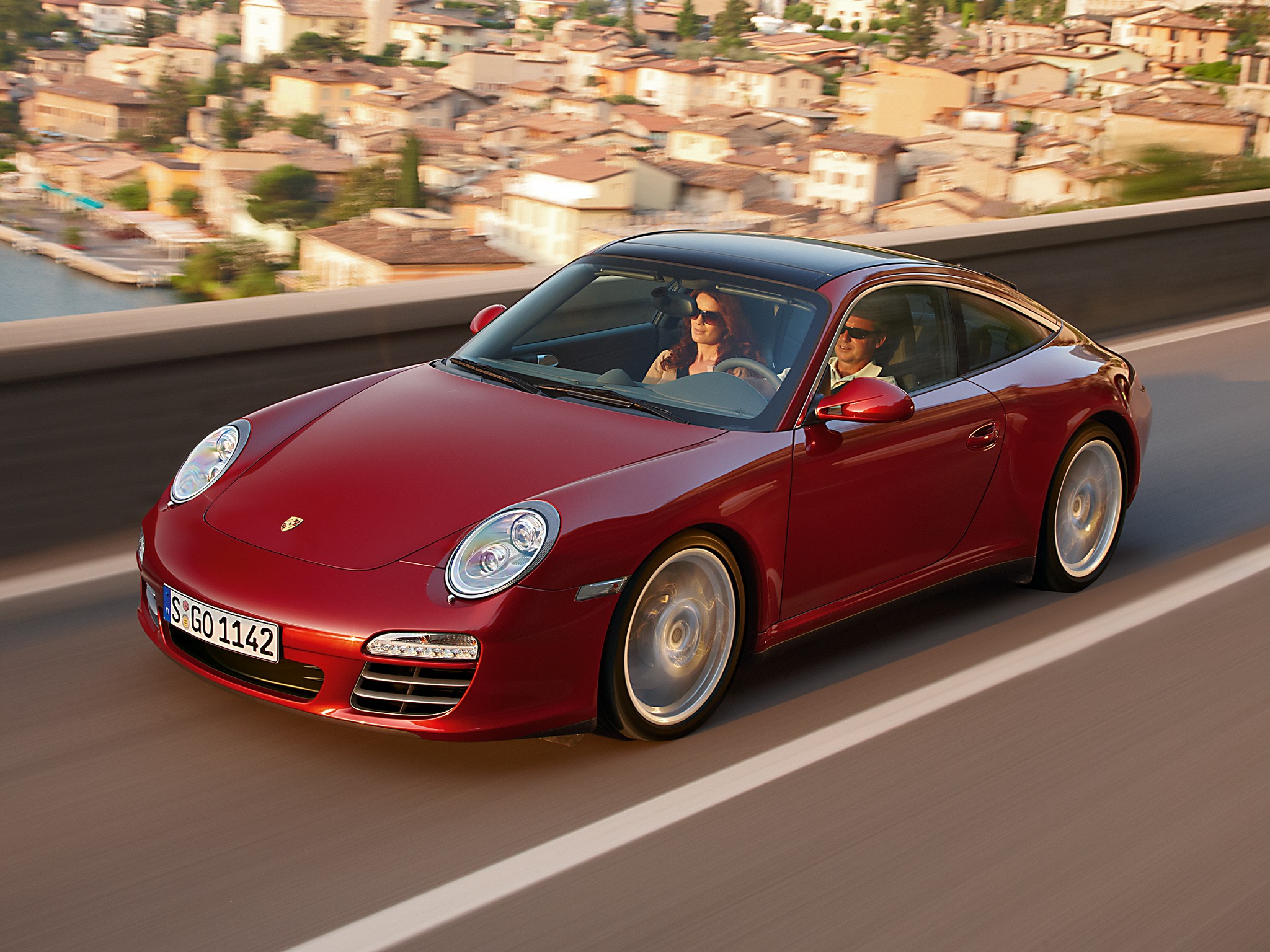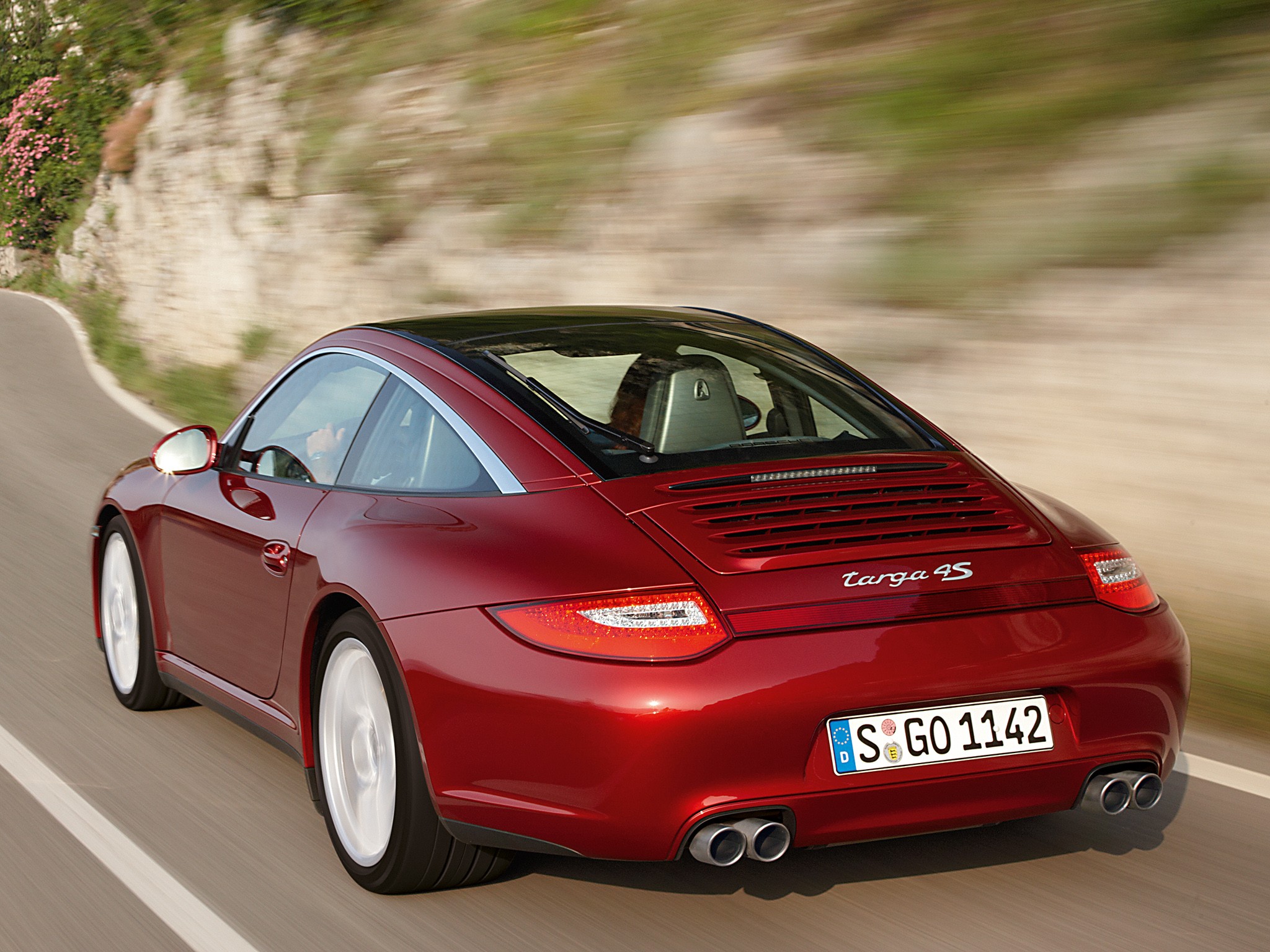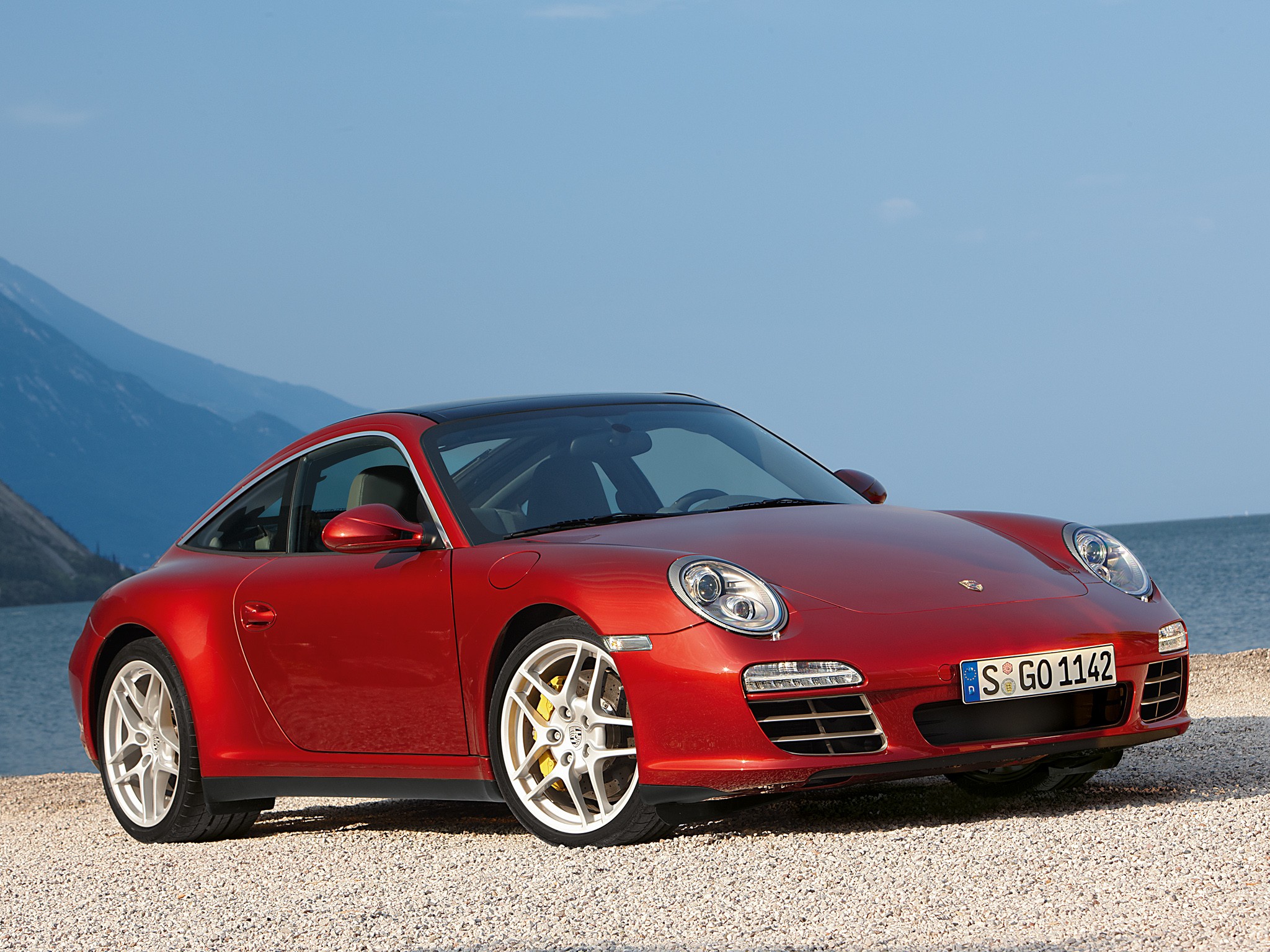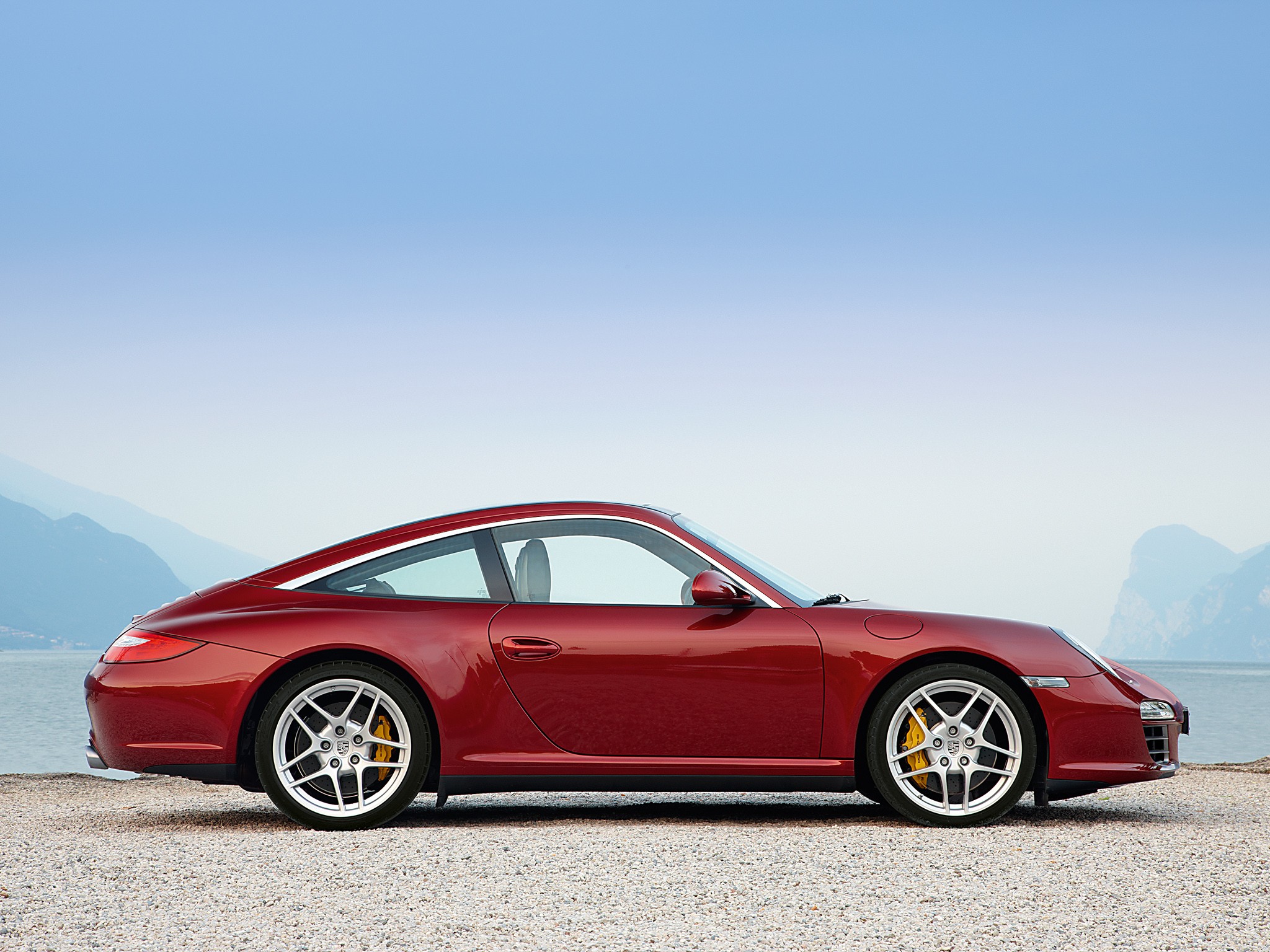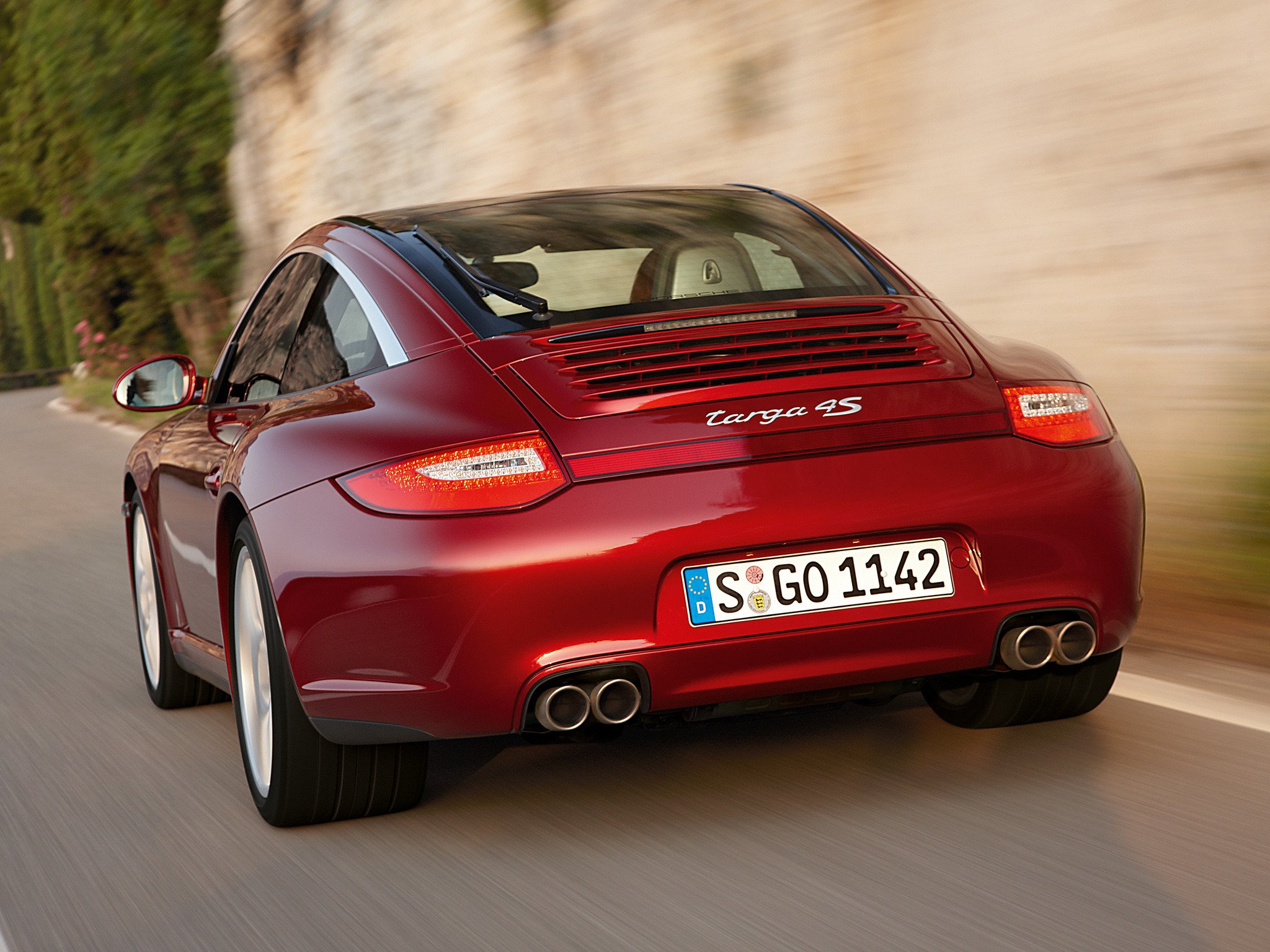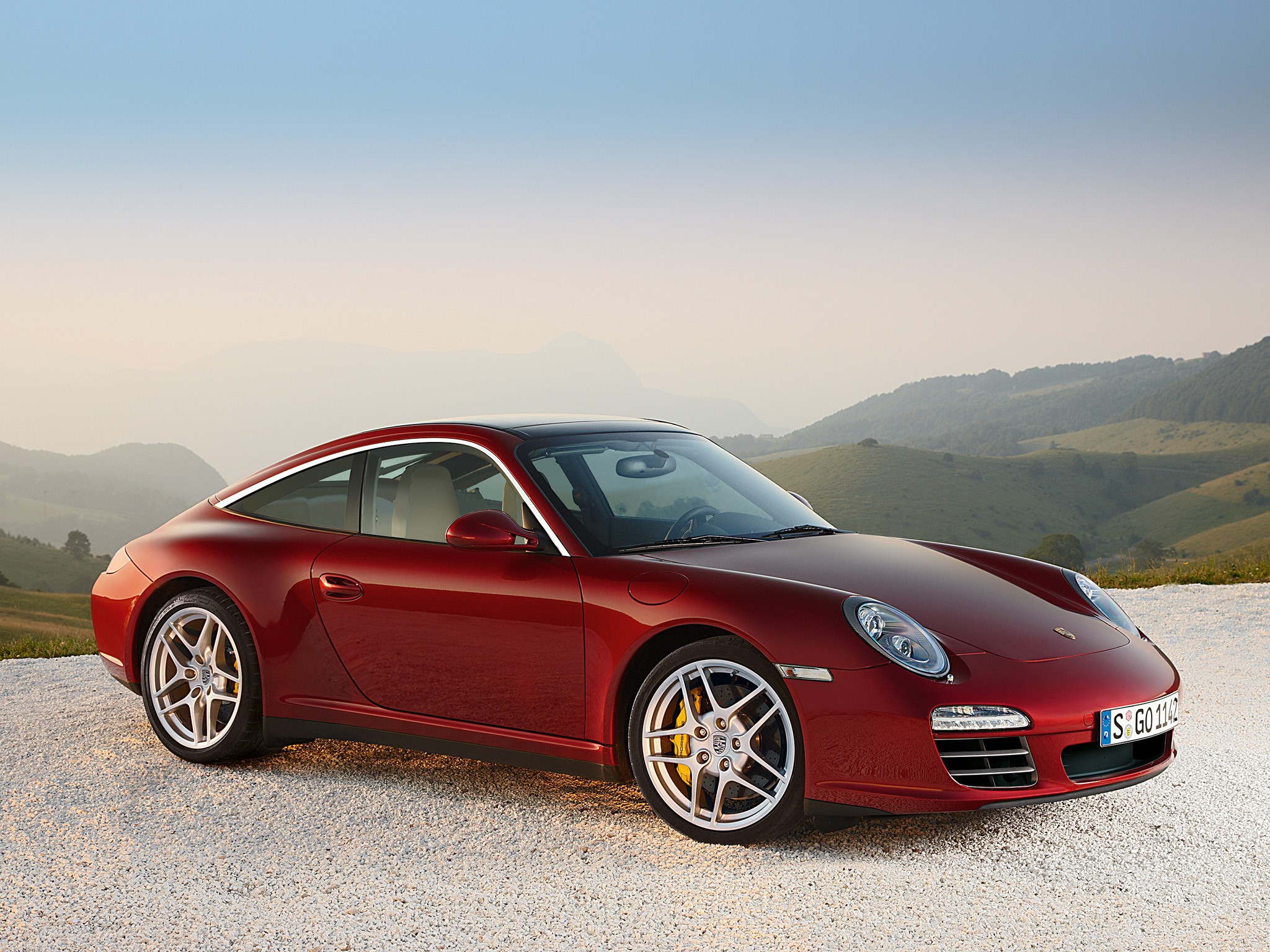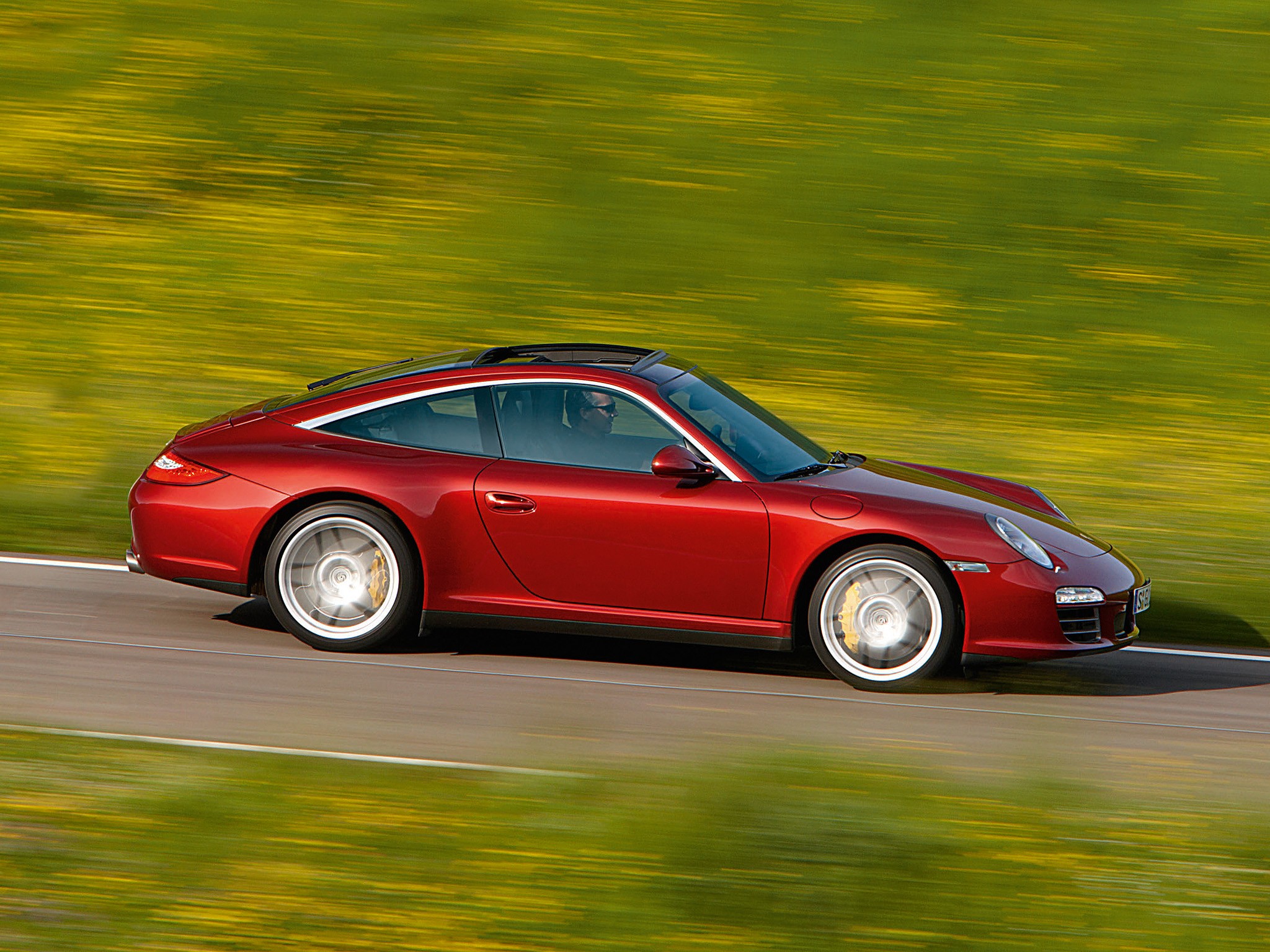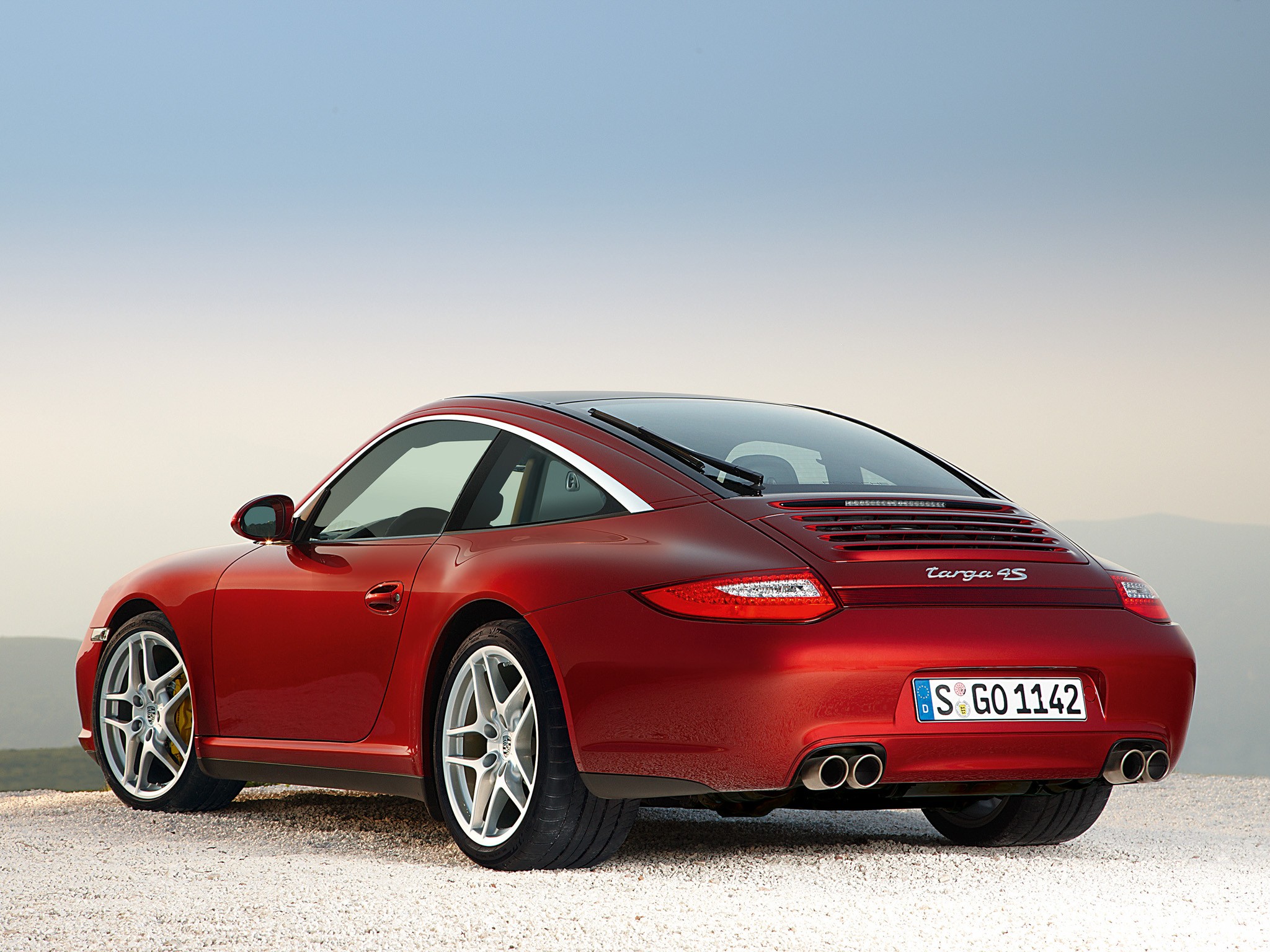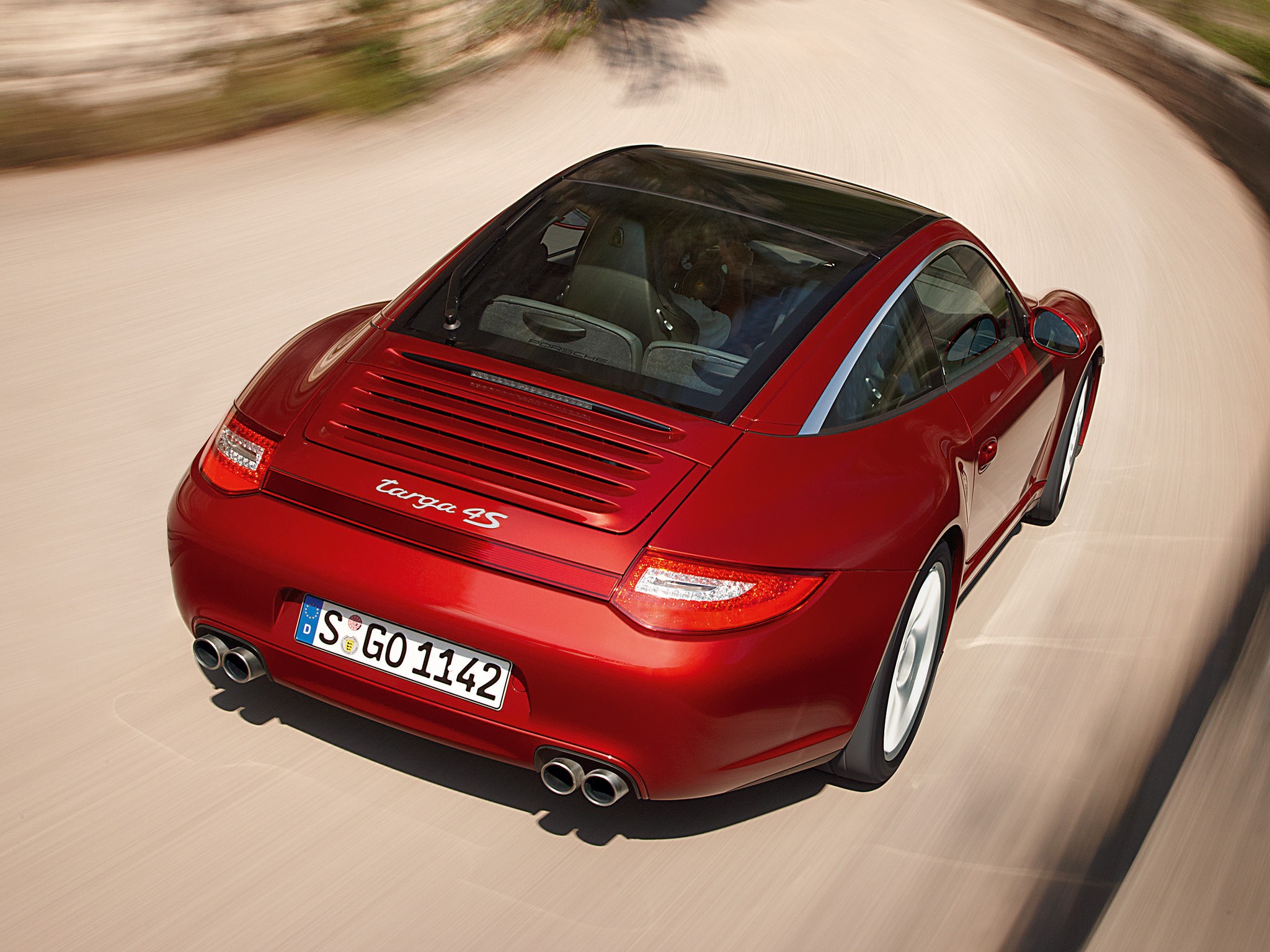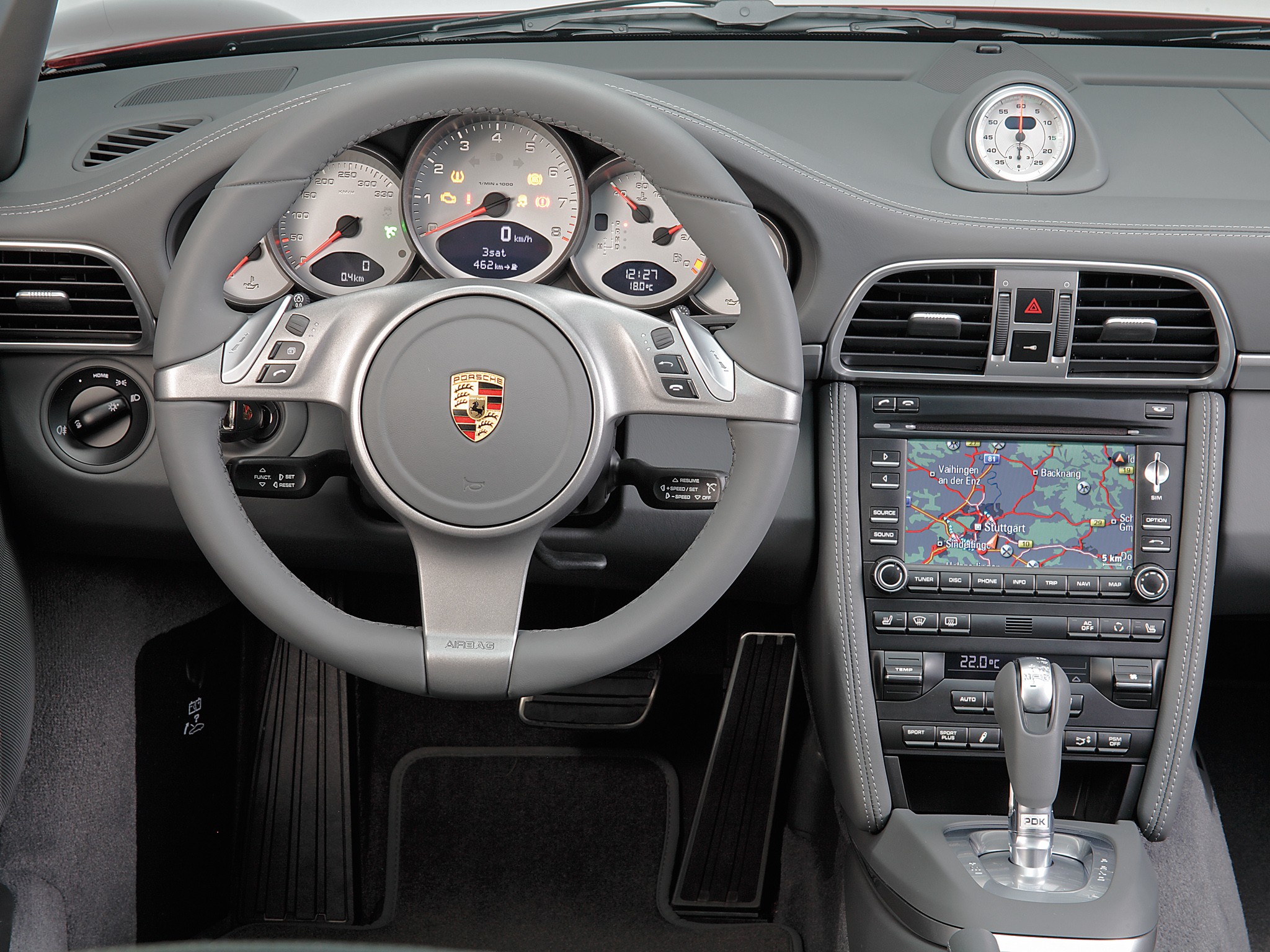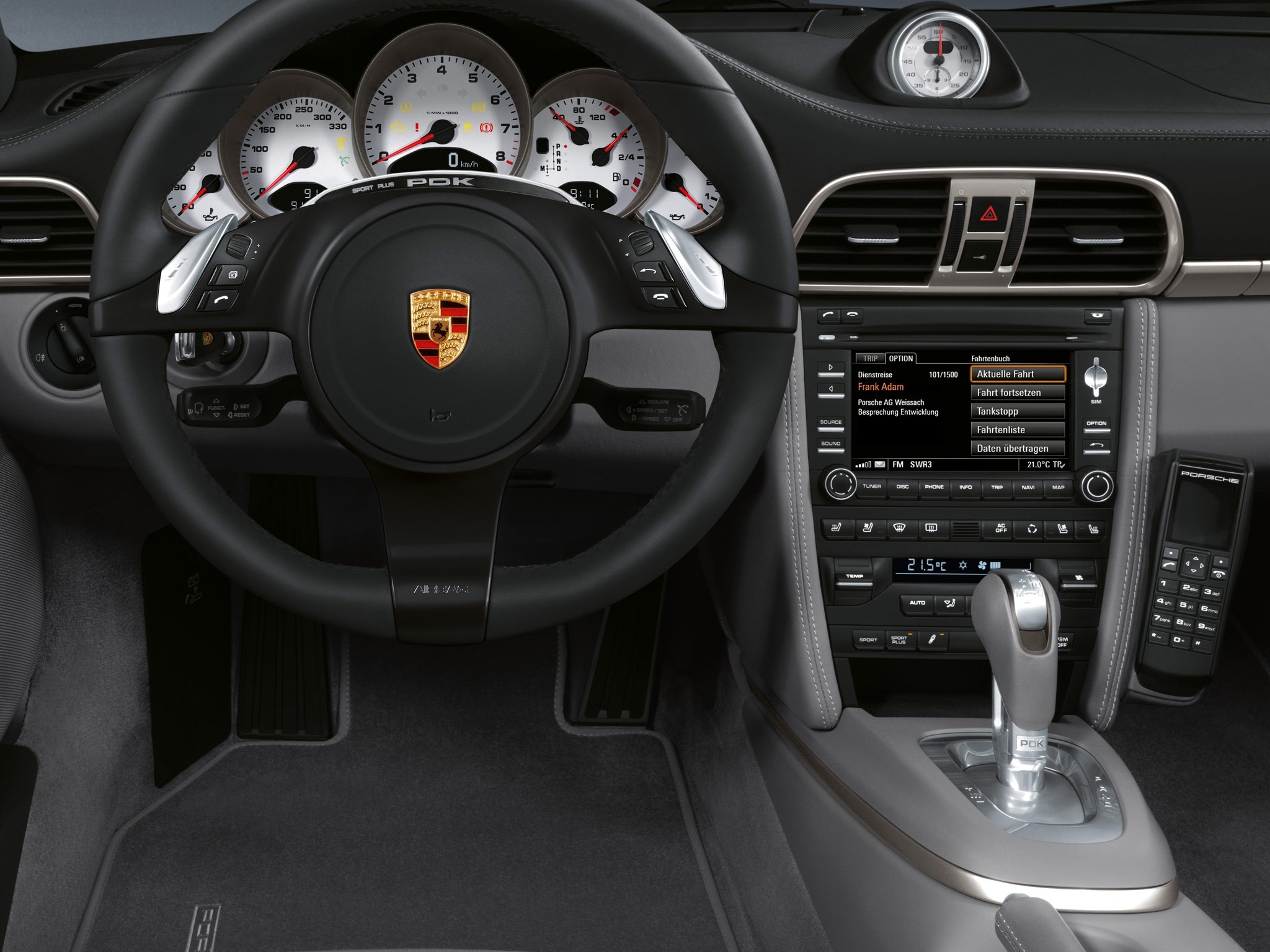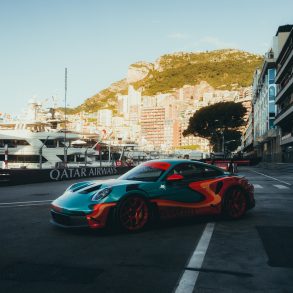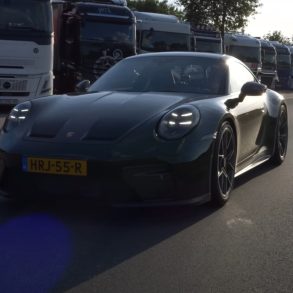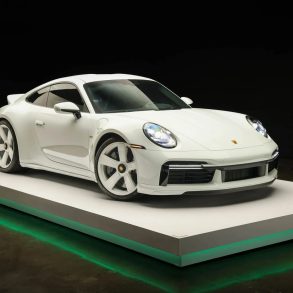(2009 – 2012) Porsche 911 Targa 4S (997.2) – Ultimate Guide
When introduced in its lineup, the Targa version of the Porsche 911 featured a removable roof panel and rear windscreen. Over time, only the roof remained removable but enhanced. While building a convertible adds more fun under the open sky, with a decrease in the driving experience due to a decrease in bodywork stiffness, the Targa solution seems to be a better option.
The Targa 4S got the same facelift as the rest of the range. It featured a new glass-roof, which blocked about two-thirds of the sunlight and took only about 17% of the thermal energy. An interior fabric roll cover increased the shade from 50 to 96%. As with the previous 996 Targa model, the most striking feature of the car is the large, sliding-glass roof and glass rear hatch, which blend sleekly into the classic 911 lines while providing the Targa with its own unique personality. It only takes 7 seconds for the roof to slide back and reveal a 4.8 square foot overhead opening. The Porsche 997 Targa’s roof system also features a semi-translucent powered sun shade for days when it’s simply too hot to sit under the glass canopy.
Once again, the 911 Targa 4S is offered in exclusively all-wheel-drive. Available with either a 3.6 litre flat 6 in the Targa 4, or with a more powerful 3.8 litre flat 6 in the Targa 4S, the new car offers almost all the fun of a convertible without sacrificing the dynamic abilities of a hardtop. An important upgrade for the 2008 Targa 4S was underneath the car. It featured a 3.8-liter engine that cranked up 385 hp, 40 hp more than its Targa 4 sibling, which had a 3.6-liter unit. A new, PDK 7-speed dual-clutch gearbox was installed on the car, replacing the older 6-speed automatic.
In terms of performance, the Targa 4 sprints to 60 mph in 5.3 seconds and tops out at 174 mph. While the Targa 4S gets to 60 mph in 4.9 seconds and top out at 179 mph. As with other 911 models, a six-speed manual transmission is standard equipment, with a Tiptronic S semi-auto available as an option.
Inside, the Targa 4 S featured a cabin better organized than its coupe sibling, due to the rear opening windscreen. That allowed an increase for the storage compartment behind the rear seats. With the seatbacks folded, the result was a storage compartment larger and more convenient than the trunk itself.
Pictures
Press Release
Porsche 911 Targa is without doubt the most avantgarde 911, a car absolutely unique the world over in its style and character. Introducing the two new 911 Targa 4 and 911 Targa 4S models, Porsche is now concluding the fastest generation change ever seen within the 911 model family. And at the same time this is one of the most comprehensive changeovers, two brand-new power units with direct fuel injection improving both performance and economy at the same time, the fast-shifting Porsche-Doppelkupplungsgetriebe replacing the former optional Tiptronic S automatic transmission and electronically controlled PTM Porsche Traction Management taking the place of the former all-wheel drive with its viscous clutch.
Featured in the new Targa, this wide range of impressive new technologies comes together with a very special version of the 911 offering truly unique features in every respect.
Glass roof with roll cover and wind deflector
The highlight of the 911 Targa is the large glass roof measuring no less than 1.54 square metres in size. A highly effective UV filter in the roof protects the car’s occupants from excessive sunshine, enabling the driver and passengers to enjoy the journey even in outside temperatures of more than 30° C or 86° F, in conjunction with the automatic air conditioning featured as standard. This is also made possible by the special glass used on the roof, the glazing letting through about one-third of the sunlight but only about 17 per cent of the thermal energy.
The interior therefore remains pleasantly bright, an electrically controlled roll cover serving to further reduce sunglare whenever necessary.
The new fabric used on the roll cover now ensures even greater privacy and increases the degree of shade protection from 50 to 96 per cent, equal to a reduction in brightness from 1,400 to 600 lux or, in other terms, to normal room illumination.
The roof module is made up of the front glass sliding roof moving to and fro with its integrated roll cover and the folding tailgate. The roof and roll cover are controlled together by a new combination of pull and push buttons integrated in the centre console. The rear button serves to open and close the glass roof, the front button performs the same functions on the roll cover, which may also be automatically opened and closed by an additional tipping function.
When opened, the roof first moves down and then to the rear, beneath the rear window. At the same time an automatically controlled multiple-plate wind deflector will move up to keep the interior of the car free of draughts, enabling the occupants to talk freely to one another even at high speeds or enjoy the sound of their audio system. And last but certainly not least, the avoidance of draughts makes it possible to drive with the roof down even in winter in low temperatures.
The roof opens or closes very conveniently within just seven seconds, the front glass cover gliding beneath the glass tailgate when opened. Moved completely to the rear, the roof leaves an opening measuring about half a metre in length and with a total area of 0.45 square metres.
For safety reasons the tailgate must be closed when opening the roof, while conversely the roof must be closed before opening the tailgate.
Unique: the 911 tailgate model
The Targa is the only model in the 911 range to feature a folding tailgate. Opening the tailgate and with the rear-seat backrests folded down, the driver and passengers have access to no less than 230 litres (8.1 cu ft) of luggage space behind the front seats, with very easy and convenient loading conditions. Just for comparison, the capacity of this storage space alone is 25 litres larger than in the Coupé.
The rear window locking and unlocking electrically is made of tinted single-layer security glass and comes as an option with a windscreen wiper integrated in the window.
With the car at a standstill, the folding rear window opens either via a switch in the doorsill on the driver’s side or from outside via a button on the key to the car by remote control. When opened, the rear window is raised by approximately 20 millimetres and may then be conveniently moved into position by hand. Two gas springs behind the window trim at the side make opening the glass tailgate up to an angle of approximately 60° very easy and convenient, with any rainwater possibly on the rear window flowing down when the window is opened through the water gutter integrated at the rear end of the sliding roof cover.
To close the tailgate, all you do is place it on its lock and press the tailgate down slightly, the electrical closing mechanism then automatically completing the closing process on the last few millimetres.
An additional eye-catcher on the 911 Targa is the high-gloss polished and eloxy-plated aluminium trim bars stretching along the roofline from the A-pillars all the way to the bottom of the C-pillars. Beneath the elegant roofline the side windows flow to the rear in a sharp angle – again a typical design feature characterising the Porsche 911 Targa.
The dynamic and powerful look of the 911 Targa is quite literally rounded off by the widely flared rear wheel arches, the rear track clearly proving that the Targa is based on the chassis of the 911 Carrera 4 with all-wheel drive.
Elegant and powerful design featuring new lights technology
In its design, the new 911 Targa reflects the all the qualities offered by the high-tech powertrain. One example is the look of the new front end, with the focus on both dynamics and outstanding supremacy.
The somewhat larger outer air intakes give the 911 a truly superior look, clearly expressing the outstanding potential of the new generation. All models in the 911 range now come as standard with bi-xenon headlights and LED technology for the daytime driving lights, the positioning lights and the strikingly designed rear-light clusters.
Yet a further feature Porsche is offering for the first time on the new 911 is the Dynamic Bending Lights never seen before on a Porsche sports car. In this case the light beam from the bi-xenon headlights follows the driver’s steering commands with the accuracy of computerised steering control, adjusting consistently to the speed of the car. And remaining active even with the high beams switched on, the Bending Lights improve driver visibility at all times.
Yet a further sign of distinction on the all-wheel-drive models – and therefore also on the Targa – is the rear light band connecting the two rear-light clusters with one another. This gives even greater emphasis to the body 44 millimetres or 1.73″ wider than on the rearwheel- drive model, making the rear end even broader and more muscular in its style and appearance.
In their shape and design, the rear-light clusters merge smoothly and harmoniously into this overall design philosophy, the lights now tapering out at the side to give the car an elegant and sporting touch all in one. And last but not least, each of the two rear-light clusters is made up of no less than 60 LEDs used in part for several functions.
The latest model series in the new generation of the 911 comes in two different variants, as the Porsche 911 Targa 4 and the 911 Targa 4S. The “standard” model is powered by a 3.6-litre flat-six with maximum output of 345 bhp (254 kW), good for a top speed of 284 km/h or 176 mph. The power unit of the Porsche 911 Targa 4S, in turn, displacing 3.8 litres, develops an even more substantial 385 bhp (283 kW), accelerating Porsche’s unique Targa model to no less than 297 km/h or 184 mph.
Porsche Direct Fuel Injection: More Power, Less Fuel
Introducing the new Carrera engines, Porsche now offers Direct Fuel Injection or DFI for short also in the company’s sports cars. With the fuel/air mixture formed directly in the combustion chamber, the new engines are able to generate more energy on less fuel, with the new engines offering outstanding features that clearly speak for themselves: Depending on the model and its equipment, the new Targa offers up to 8.5 per cent more power and performance on 11.2 per cent less fuel and with CO2 emissions down by 13.6 per cent.
Direct fuel injection has a positive impact not only on the engines’ efficiency, but also on their characteristics. And this the driver will feel right away – with fuel being injected in fractions of a second before the beginning of the energy cycle, the engines respond even more spontaneously to even the slightest movement of the gas pedal, giving the new Targa quite outstanding performance: The Porsche 911 Targa 4 accelerates from a standstill to 100 km/h in just 5.2 seconds, the even more powerful S-model completing the same exercise even more quickly in 4.9 seconds – in each case with the manual six-speed gearbox.
The optional PDK Porsche-Doppelkupplungsgetriebe or double-clutch gearbox shifts gears even faster to set an even higher standard, the Targa 4 with its 3.6-litre power unit accelerating to 100 km/h in exactly 5.0 seconds, the Targa 4S offering even faster acceleration to 100 km/h in 4.7 seconds. And the big advantage for the customer is that even the less skilled and experienced driver is able to achieve this kind of acceleration at all times under appropriate road conditions thanks to PDK technology.
Direct fuel injection on the new flat-six power units is conceived for homogeneous operation, the fuel/air mixture being distributed smoothly and consistently in the combustion chamber for an optimum combustion process. This, in turn, guarantees maximum catalytic efficiency, keeping harmful emissions to an absolute minimum, both the Targa 4 and the Targa 4S outperforming the strict emission limits of the Euro 5 standard not even coming into force until September 2009.
The two six-cylinder horizontally-opposed power units are brand-new from the ground up. On both the 3.6 and the 3.8-litre, the crankshaft and combustion chambers come in completely new geometry, the smaller stroke and larger bore leaving the effective engine capacity almost unchanged, but further enhancing the engine’s free-revving performance and spontaneity.
Creating the new engines, Porsche’s engineers have also introduced new, single-piece cylinder heads not only lighter, but also more stable than the conventional units. And as in the past, the cylinder heads incorporate Porsche VarioCam Plus variable valve management with adjustment of the valve timing on the intake side and valve lift switchover.
The two big advantages of VarioCam Plus are, first, the optimum power and torque provided in this way and, second, the improvement of fuel economy, emissions and the engine’s refinement and motoring culture. In conjunction with the new direct fuel injection, this offers an ideal symbiosis increasing both the output and torque of the engine on a further reduction of fuel consumption.
On-demand oil pump and external coolant pump
Yet a further step taken to enhance the efficiency of Porsche’s new power units was to optimise the oil system and the general balance of oil. The oil circuit in the new engines follows the principle of integrated dry sump lubrication and is made up of an all-round system incorporating four suction or scavenge pumps and, for the first time, a pressure oil pump controlled electronically according to current demand. Masterminded by the engine management system, the oil pump does not consume more energy than is really required and at the same time ensures absolutely the right level of lubrication at all times.
A further new feature is the configuration and position of the coolant pump as a separate module outside of the crankcase. The big advantage of this concept is the flexible adjustment of coolant pump size and easier repair/maintenance whenever required. And to adjust the coolant pump to the extra power of the engine, at the same time ensuring adequate engine cooling, the maximum volume flow in the new coolant pump is up by approximately 20 per cent.
New intake manifold with dual air filter
The new flat-six power units are fed with air through a brand-new intake manifold proudly bearing the words “Direct Fuel Injection” and, depending on the model, the numbers “3.6” or, respectively, “3.8”.
The air filter system now comes with two chambers featuring two intake points and separate intake funnels as well as two round filters incorporated in the rear lid. Thanks to the flow resistance reduced through this concept, inspection intervals for the air filter elements are extended from 60,000 to 90,000 kilometres.
The intake manifolds on the new engines are also brand-new in their design and configuration, being made of a special plastic material with a resonance pipe and additional resonance chambers to provide exactly the right acoustic effect. Thanks to the switching resonance flap, air vibration in the intake system of the 3.8-litre power unit may indeed be adjusted to the respective engine speed, improving the cylinder charge in the interest of higher torque right from the start at low engine speeds.
Exhaust system even more effective than before
All new 911 Targa models have an exhaust system measuring the same in length. As in the past, the 3.6-litre Targa is distinguished by two separate oval tailpipes, while the Targa 4S with its 3.8-litre engine comes with two dual tailpipes made of brushed stainless steel. Interacting with the various other improvements and technologies featured on the engines, the new cars fulfil both the EU5 exhaust emission limits in Europe and the LEV II regulations in the USA.
Faster, More Precise, More Economical
In standard trim the new Targa models come with a manual six-speed transmission offering a particularly smooth and precise gearshift. For the purposes of all-wheel drive, the transmission comes with an additional output drive shaft connecting the main shaft to the front axle.
Porsche’s new PDK Doppelkupplungsgetriebe or double-clutch gearbox offering no less than seven gears is now available as a highly interesting optional alternative with qualities going beyond even those of the manual gearbox and replacing the former Tiptronic S.
Regardless of the type of transmission the customer ultimately chooses, both Targa models come as standard with a Start-Off Assistant maintaining the brake pressure exerted by the driver when pressing down the brake pedal for a smooth and comfortable process of setting off on an uphill gradient without requiring the driver to use the handbrake.
New Doppelkupplungsgetriebe for even greater driving dynamics
Introducing the new generation of the 911 Carrera, Porsche is for the first time offering an optional Doppelkupplungsgetriebe or double-clutch gearbox in a road-going sports car.
In principle the Porsche PDK double-clutch gearbox is made up of a conventional manual gearbox divided into two gearbox units and a hydraulic control unit. The gearbox is literally “built around” two wet clutches on one common shaft, operated, cooled and lubricated by the transmission fluid. One clutch is for the first gearbox unit with the uneven gears and reverse gear, the other clutch for the second gearbox unit with the even gears. Via a large number of pressure valves the hydraulic control unit masterminds both the wet clutches and the gearshift cylinders, placing the gear ratio required in mesh.
The fundamental difference versus a conventional manual gearbox is that the gearshift perceived by the driver is not a result of the gears changing in the transmission, but rather of the changeover from one clutch in positive engagement to the other. In this process the clutch on one gearbox unit is opened and the other clutch is closed simultaneously, at exactly the same time and in one process.
The big advantage is an even faster gearshift versus a conventional manual gearbox and automatic transmission, with the gears already in mesh when the driver shifts from one gear to the other, avoiding the slightest interruption of traction during gear change. A further advantage is the lower weight of the PDK gearbox some ten kilos lighter than the former Tiptronic S transmission despite the use of two additional gears.
The new double-clutch gearbox comes with seven forward and one reverse gear. Within this configuration gears 1-6 feature a particularly sporting ratio, the car reaching its top speed in sixth gear. Seventh gear, therefore, has a longer overall transmission ratio in the interest of enhanced fuel economy.
The driver is able to shift the double-clutch gearbox either through paddles on the steering wheel spokes or through the selector lever in the centre console.
Shifting gears quickly, smoothly and comfortably
PDK offers an even more sporting and dynamic style of motoring as well as enhanced agility for greater driving pleasure than Tiptronic S. The new gearbox shifts gears up to 60 per cent faster than the former automatic transmission – and at the same time the driver need not make any concessions in terms of comfort in a 911 equipped with PDK, with the new gearbox shifting gears smoothly and gently through the automated clutch operation and gearshift process.
A further feature of PDK is the reduction of power loss to a minimum thanks to the high level of mechanical efficiency and the double clutch optimised to avoid losses. So while the Porsche 911 Targa 4 with Tiptronic S, that is the former model, consumed 11.6 litres/100 kilometres (equal to 24.3 mpg imp) under the EU standard, the new model with PDK outperforms this consumption figure by 1.3 litres, reducing average fuel consumption in the EU cycle to just 10.3 litres, equal to 27.4 mpg imp. The S-model presents the same example, the former 3.8-litre version with Tiptronic S consuming 11.9 litres/100 kilometres (equal to 23.7 mpg imp), while the new 911 Targa 4S with PDK reduces combined fuel consumption in the EU cycle to just 10.7 litres/100 km, equal to 26.4 mpg imp.
Sports Chrono Package Plus with Launch Control and racing gearshift
An important option available on the new 911 Targa 4/4S with PDK is the Sports Chrono Package Plus featuring an additional Launch Control function and a gearshift strategy for extremely sporting driving characteristics. As on the previous model, Sports Chrono Package Plus comprises the following highlights also on the new models:
- An analogue and digital stopwatch on the instrument panel.
- A sports mode for the engine, suspension (PASM) and transmission including two sports buttons (SPORTS and SPORTS PLUS).
- A performance display in the PCM.
- A separate memory function.
Launch Control is an assistance program for optimum acceleration when setting off. The function is activated by pressing the SPORTS PLUS button in the centre console. To set off in racing style with the help of Launch Control, the driver first presses down the brake pedal with one foot and then quickly pushes down the gas pedal with the other, overriding the kickdown stage in the process and revving the engine up to a speed of approximately 6500 rpm. PDK management will then inform PTM Porsche Traction Management of the upcoming start, PTM switching over to 100 per cent all-wheel drive. Then, as soon as the driver takes his foot off the brake pedal, the transmission will switch to optimum wheel slip and the car will set off with maximum acceleration. In this case acceleration from 0 – 100 km/h is reduced by Launch Control on each model by 0.2 seconds.
The second new function of the Sports Chrono Package Plus in conjunction with PDK is a gearshift strategy for extremely sporting and dynamic driving performance, offering optimised gearshift points for the fastest possible shift times and exactly the right driving characteristics for the race track. Again, this function is activated by the SPORTS PLUS button, PDK switching over to the fastest conceivable reaction and gearshift times and shifting gears almost instantaneously, twice as fast as with Tiptronic S.
In the process PDK shifts up under full load at the absolute speed limit with excess torque, a 911 Targa equipped with PDK accelerating from a standstill to 100 km/h leaving a 911 Targa with Tiptronic S several lengths behind.
PTM: Fast and Always Ready to Go
Benefiting from electronically controlled PTM Porsche Traction Management featured for the first time in the 911 Turbo, the new 911 Targa boasting this outstanding all-wheel drive is able to convert the extra power and torque of the engine even more efficiently into outstanding acceleration and traction.
On cars fitted with PTM, an electromagnetically controlled multiple-plate clutch reacting within fractions of a second ensures the optimum distribution of power front-to-rear. And providing this power distribution within 100 milliseconds at the very most, PTM is faster than the driver will ever notice, meaning that Porsche all-wheel drive can literally “look ahead”.
In practice this means superior agility on narrow country roads, outstanding traction and excellent driving safety also in extreme manoeuvres at very high speeds. With these features, Porsche Traction Management is one of the most efficient and, at the same time, lightest high-performance all-wheel-drive systems in the market.
Five basic functions for all driving requirements
To offer these qualities in driving dynamics, PTM comes with five essential functions:
- Standard distribution of torque and power: Under everyday driving conditions the management unit spreads out engine power between the front and rear axle infinitely as a function of current driving conditions. To do so, the torque and power required on the front axle is determined regularly within milliseconds, offering the driver a significantly higher standard of driving stability above all at very high speeds.
- Proactive management: Checking out typical parameters, PTM is able to detect dynamic changes in driving conditions at an early point in time and avoid drive slip in advance. When setting off, for example, the system determines how hard the driver is pressing down the gas pedal. Then, before the engine is even able to convert this command from the driver into power and torque, PTM closes the multiple-plate clutch to a point where the wheels will not slip.
- Spin control: On account of the car’s high torque, the 911 may well reach its traction limit on the rear axle when accelerating on, say, a wet surface. So here again, the multiple-plate clutch intervenes more vigorously, feeding more power and torque to the front axle.
- Oversteer correction: Whenever the car threatens to swerve around at the outside in a bend on account of adverse conditions such as wet leaves on the road, more power is fed to the front axle in order to stabilise the car in this dynamic driving process. Another advantage of PTM in this case is that the system considers the steering angle in transmitting power to the front axle. So whenever the driver countersteers while the car is oversteering, PTM will adjust the flow of power going to the front axle to stabilise the car even more quickly and efficiently.
- Understeer correction: Should the car, in the opposite situation, threaten to “push out” of a bend over its front wheels, PTM will reduce the amount of power and traction transmitted to the front axle. Again, PTM, thanks to the very precise and fast sensors, will respond in both cases before the driver even notices any lack of stability. The result also in this case is quick and active stabilisation of the car for fast and dynamic behaviour in bends. And communicating in the process with PSM Porsche Stability Management, PTM ensures a very high level of safety reserves.
Mechanical differential lock featured as standard
The new Targa 4 models come as standard with a limited-slip differential on the rear axle providing 22 per cent locking action under power and 27 per cent in overrun.
The mechanical differential lock on the rear axle raises the driving dynamics of fully controlled PTM Porsche Traction Management to an even higher level, improving traction on changing surfaces when driving to the limit in bends and increasing driving stability under load change in bends and on winding roads.
The More Comfortable 911
The particular style and elegance of the 911 Targa 4 and Targa 4S comes out clearly not only in the looks of the car, but also in its driving behaviour and performance on the road with a perfect combination of motoring comfort, on the one hand, and dynamic performance also in fast bends, on the other.
As before, the Porsche 911 Targa 4 comes with conventional suspension, while the Targa 4S features active suspension with PASM Porsche Active Suspension Management. And while the suspension components are largely the same as on the 911 Carrera 4 and Carrera 4S, the springs and anti-roll bars front and rear are specifically tailored to the Targa, all four coil springs showing a lower spring rate in the interest of extra comfort.
The active suspension also comes with an appropriate set-up and adapted configuration. Lowered by 10 millimetres or 0.39″ through PASM suspension, the car offers the driver two programs, either PASM Normal or PASM Sport.
The Normal mode keeps the dampers in a sporting but comfortable set-up changing to a sporting and firmer mode as soon as the driver adopts a more dynamic style of motoring. Particularly on long distances, this gives the car’s occupants a significantly higher level of motoring comfort, with PASM filtering out small and medium bumps on the road even better than the “regular” suspension.
The Sport mode, finally, activates a harder damper control line right from the start in support of an even more dynamic and agile style of motoring.
Wide track for stable handling
A common feature shared by all models with all-wheel drive is the wide rear end and the wider track at the rear compared with the rear-wheel-drive models. Up front the 911 Targa 4 comes on 8J x 18 wheels running on 235/40 ZR 18 tyres, while the 4S features 8J x 19 wheels on 235/35 ZR 19 tyres. The rear wheels are somewhat larger still in both cases, the Targa 4 boasting 295/35 ZR 18 tyres, the Targa 4S running on tyres measuring 305/30 ZR 19. And since both tyres come on rims with low hump depth, rear track is increased to 1548 millimetres or 60.94″ typical of all-wheel drive.
This wider track not only looks good, but also benefits the car’s driving dynamics, the footprint of the tyres further out to the side giving the body even better support, minimising roll movements and, as a result, enhancing the car’s lateral acceleration.
TPC Tyre Pressure Control now acting even faster
Introducing the new generation of the 911, Porsche’s engineers have enhanced the optional TPC Tyre Pressure Control to an even higher standard, making the system even faster and more efficient.
Being initialised right from the start when the driver opens the door, TPC is able to start checking tyre pressure as soon as the driver switches on the ignition, presenting the tyre pressure ratings in the instrument cluster within a matter of seconds. Even after changing a tyre, in which case the system has to register the new wheel electronics inside the tyre and complete a learning process, the driver will be informed of the new tyre pressure ratings at the latest within three minutes.
A further advantage of the new system is that even when the electronic wheel monitors fail to operate in one or two wheels, tyre pressure is still monitored appropriately in the other wheels.
Apart from extra safety prior to and in the case of possible tyre damage, TPC Tyre Pressure Control, by enabling the driver to check the correct tyre pressure in a very simple and straightforward process, protects the tyres from unequal wear and thus helps to avoid excessive fuel consumption.
Brake system optimised to an even higher standard
A further objective in developing the new models was to raise the level of brake performance to an even higher standard in accordance with the greater power and performance of the cars as such. Precisely this is why the various Targa 4 models come with a brake system perfectly tailored to their specific driving characteristics, the brake callipers as usual informing the beholder of the brake system fitted: On the standard brake system featured on the 3.6-litre Targa 4 the brake callipers come in black, on the S-model with its 3.8-litre power unit the callipers are finished in red, and the brake callipers on the optional PCCB Porsche Ceramic Composite Brakes, finally, come in yellow.
As on the other models in the new generation of the 911, the brake discs at the front have been increased in diameter to 330 millimetres or 12.99″ and measure 28 millimetres or 1.10″ in thickness. Larger brake air spoilers on the front track arms serve to improve the ventilation of the brakes and to increase the stiffness of the four-piston monobloc swing callipers made of aluminium rods. Additional bars connect the two sides bearing the pistons, enhancing brake performance and the system’s fading-free brake qualities to an even higher standard.
The rear wheels now come with cross-drilled and inner-vented brake discs measuring 330 mm in diameter instead of formerly 299 millimetres (12.99 instead of 11.77″) in, and are again 28 millimetres (1.10″) thick. In this case the four piston aluminium monobloc swing callipers are cooled through additional openings in the underfloor panel.
The brakes on the S-model feature four-piston aluminium monobloc swing callipers front and rear, together with cross-drilled and inner-vented brake discs. Brake dimensions are 330 x 34 millimetres (12.99 x 1.34″) on the front wheels and 330 x 28 millimetres (12.99 x 1.10″) at the rear.
To adjust the brakes to the car’s even higher level of performance, brake ventilation on the front axle is improved by larger brake air spoilers and there is additional, active ventilation of the brakes at the rear.
Optional ceramic brakes
Both models are available as an option with PCCB Porsche Ceramic Composite Brakes. Measuring 350 millimetres or 13.78″ in diameter, these cross-drilled, inner-vented ceramic brake discs weight approximately 50 per cent less than comparable grey cast-iron brake discs.
In conjunction with their special brake linings, the ceramic brake discs immediately build up a high and, in particular, consistent frictional coefficient in the deceleration process. Abrasion is much smaller than in the case of grey cast-iron brake discs thanks to the extreme surface hardness of the ceramic discs. The service life of the brake discs, in turn, is correspondingly longer, also because the ceramic material is fully resistant to corrosion.
Exclusive and Sophisticated
Beneath the glass roof of the 911 Targa, the discreet but luxurious interior of the Porsche 911 comes out in particular class and style. Special emphasis is given by the designers to the harmony of colours and trim, with all surfaces coming in an extremely sophisticated finish providing a very pleasant surface touch.
On both models the gearshift lever, steering wheel rim, handbrake handle, the cover on the storage box in the centre console, the cover on the door storage box and the door closing handle all come in leather. The seat centre strips as well as the side supports and the headrests on the front seats are likewise finished in leather, the sports steering wheel, the dials in the instrument cluster finished in aluminium, and the interior components in aluminium look such as the air vents, the ornamental trim on the instrument panel as well as the gearshift and gear selector lever, all boasting that typical Porsche S look.
PCM with touchscreen monitor
To improve operating comfort and ergonomics to an even higher standard, Porsche’s engineers and designers have developed an optimised centre console for the new generation of the 911. The most important features in this context are the enhanced display and control concept of PCM Porsche Communication Management. Serving as the central control unit for all audio and communication functions, PCM now offers an even higher standard of performance, greater versatility, and much easier control.
The main feature of the new PCM unit is the touchscreen monitor with its long-service, easyto- clean surface layer. The monitor itself has been increased in size from 5.8 to 6.5 inches, an improvement over the former generation made possible by integrating the hard keys so far fitted next to the monitor directly into the touchscreen control, thus halving the number of buttons to a total of just 16.
Menu guidance is particularly clear and logical, the driver or front passenger immediately finding the most important functions on the main menu. A number of functions used less rarely have been moved to the second menu level (OPTION), thus reducing the number of menu fields versus the former system from five to three.
Outstanding sound and reception
The radio in the 911 Targa comes with up to 48 memory slots, an FM double tuner with RDS and the latest diversity function – in the background the radio constantly looks for the best frequency of the station chosen and combines one or several of the four FM radio aerials for optimum reception at all times (scan and phase diversity).
The integrated drive is able to play back music either from a CD or from an audio and video DVD – in conjunction with the BOSE® Surround Sound System available as an option also in the 5.1 Discrete Surround format, otherwise in stereo. The formats supported by the system are MP3, AAC, WMA, Dolby Digital, MLP, and DTS.
A six CD/DVD changer integrated in PCM is available as an option, taking the place of the standard single CD/DVD player and offering the driver direct and convenient control and operation of the system. The changer itself supports the same formats as the single CD/DVD player and offers sufficient capacity for some 25, 000 minutes of music on DVDs. CDs or DVDs are loaded and ejected one after the other in the PCM shaft after previous selection of the loading bay.
A concert hall beneath a glass roof: the outstanding sound system
The optional BOSE® Surround Sound System was developed especially for Porsche and is therefore tailored perfectly to the acoustic conditions prevailing in the 911 Targa. A total of 13 loudspeakers including active subwoofers and centre speakers as well as a seven-channel digital booster ensure a truly impressive experience in sound, output of the new booster being increased from 325 to 385 Watt.
In playing audio or video DVDs, the system now offers the thrilling sound spectrum of digital 5.1 recordings where the sound is recorded from the start in a multi-channel format retaining all sound qualities without the slightest distortion.
The new optional universal audio interface also offers the possibility for the first time to connect an external audio source such as an iPod® or a USB stick then controlled conveniently via PCM. Three appropriate ports are available for this purpose in the storage box on the centre console.
The TV tuner likewise available as an option is able to receive uncoded analogue and digital DVB-T television signals. For reasons of safety and on account of legal requirements, only the sound and not the TV picture is available while driving.
For even faster calculation of routes: navigation module with hard disc
The optional PCM navigation module now comes with an integrated 40 GB hard disc covering the navigation data of most countries in each region. This allows significantly faster calculation of routes, offering the user three alternative route proposals.
The touchscreen monitor also speeds up the process of entering destinations and provides information on traffic congestion and special destinations simply by touching the symbols on the map. And last but not least, stopover points on the way such as the nearest garage may be included easily and conveniently in the current process of destination guidance.
As of scale of ten kilometres, the elevation profile is shown in the map view in colour, distinguishing between new perspective-based and the conventional two-dimensional presentation. When presenting the entire route, the map scale is consistently adjusted in order to present the remaining route as of the current location of the car all the way to the destination flag in maximum size.
Additional graphic bending signs are provided at exits from the Autobahn in the interest of better orientation and the splitscreen mode presents not only the current map section, but also a list showing upcoming driving manoeuvres as pictograms.
The enhanced navigation functions already used in the past are maintained as before, such as guidance along a route recorded in advance – referred to as backtrace navigation – as well as navigation in non-digitalized regions via the compass and GPs functions.
The electronic logbook remains available as an option, as in the past, automatically determining the car’s mileage, the route covered, the date, the time of day, as well as the point of departure and destination. A new advantage is that data may now be read out in two ways: either through the PCM Bluetooth® interface featured as standard or via a USB in conjunction with the optional universal audio interface. Then the data obtained in this way may be evaluated by the user at home on his PC, using the software provided for this purpose. This fulfils the requirements of the German tax office for the documentation of automatic logbook recordings.
Telephone module with Bluetooth® interface
The internal GSM telephone module available as an option offers superior convenience in use and optimised voice quality.
The system may be operated in two modes: First, the user may make telephone calls with the help of the SIM card inserted into the telephone; second, the user may automatically connect a compatible SAP-supporting mobile phone (SIM Access Profile) and the telephone module via Bluetooth®, in which case the mobile phone aerial is switched off only on SAP mobile phones and the exterior aerial on the car is used exclusively for making telephone calls. Depending on the mobile phone, this allows access not only to the SIM card data, but also to telephone numbers saved within the internal memory. In this case again the telephone is controlled and operated via PCM, the multifunction steering wheel or optional voice control, with the mobile phone remaining conveniently in the user’s pocket.
Once the mobile phone and PCM have been connected, PCM will recognise the appropriately configured mobile phone as soon as the user gets back into the car, automatically connecting PCM and the phone with one another. In this way the system is able to record and save up to five different mobile telephones.
The telephone module is the best solution in technical terms for the customer with a GSM Bluetooth® mobile phone. Customers with a GSM or CDMA mobile phone supporting only the HFP hands-free profile are however also able to use a convenient Bluetooth® telephone solution, since a mobile telephone preparation kit is also available as an alternative to the telephone module. Then, when establishing a connection via the hands-free profile, PCM serves only as the hands-free telephone unit for the mobile phone.
A highly convenient alternative: voice entry
The latest generation of voice entry allowing the use of full, complete words is now available in conjunction with the new hard disc navigation system in the interest of extra convenience and safety on the road. Voice control is activated by pressing the button on the steering column for the on-board computer, allowing the user to choose virtually all PCM functions through voice control.
The voice control mode enables the user to read out each menu item the way it is presented on the screen, the system recognising commands or rows of numbers regardless of the speaker and not requiring a long and tedious learning process. And last but not least, voice operation gives the user acoustic feedback and guides him through the various functions in an appropriate dialogue.
Wide range of seats for the discerning customer
Opting from a wide range of individual features, the Targa 4 customer is able to put together his or her very individual and personal car according to his personal taste. First and foremost, the new models are available with an unusually wide range of no less than five seat variants.
The options available are as follows:
- Standard seats adjusting in six directions: The seat backrest angle is adjusted electrically, the fore-and-aft position as well as seat height manually.
- Comfort seats with a driver memory function: These seats are masterminded via controls facing towards the doorsill on the seat bottom and may be adjusted in 12 directions. In addition to the adjustment options allowed by the standard seats, the seat bottom angle may be varied in this case independently of the seat backrest angle. A further highlight of these all-electric seats is the pneumatic lumbar support with four inflatable air cushions saving the level of inflation in the seat memory.
- Sports seats based on the standard seats: These seats offer even better side support ensured by even higher support elements on the seat bottom and the backrest and by enhanced support at shoulder level.
- Adaptive sports seats with driver memory: In this case the occupants enjoy all the benefits of the all-electric seats combined with enhanced side support and the special design of the sports seats. A further advantage is four-dimensional adjustment of the side supports allowing the occupant to adjust the seat bottom and the backrest individually to his or her personal measurements.
- Sports bucket seats with the bucket element made of glass- and carbon-fibre-reinforced plastic and the surface in carbon look: Thanks to the swivel point integrated in the upper hip section of the side supports, these seats combine the folding function of the backrest with absolutely excellent side support.
Ensuring a pleasant climate at all times: the new vented seats
In combination with seat heating, the new models in the 911 range are available for the first time with seat ventilation on both the standard and comfort seats. Maintaining a healthy and comfortable micro-climate between the occupant and the seat surface is indeed particularly important, since this is the part of the car the occupants come into contact with and feel longer than anything else.
Active seat ventilation therefore ensures a comfortable climate on the seat surface also in warm seasons.
To switch on seat ventilation, all the driver or front passenger has to do is press a button in the centre console: Pressing the button the first time, the occupant will first activate the highest of the three comfort levels, three blue LEDs presenting the level of ventilation switched on. This degree of ventilation is then maintained until the driver or passenger switch to another level. The only exception is that the system switches off at a surface temperature on the seat of less than 15° C in order to avoid undercooling.
The seat surface is vented precisely at those points where the occupant comes into close contact with the seat, the venting points being shown by that characteristic perforation in the seat cover.
The ventilation effect is generated by one vent each on the seat bottom and in the backrest withdrawing perspiration moisture between the occupant and surface of the seat through the perforated seat and backrest centre sections. Air flows through a special air guidance tissue and is transported through hoses beneath or behind the seat.
This quickly cools down seat surfaces heated by the sun, preventing the occupants from sweating while driving. And even in the highest stage, the two vents are so quiet that the driver or passenger will hardly hear them while driving.
Last but not least, seat ventilation may be combined with temperature control on the seat heating, again ensuring ongoing withdrawal of moisture combined with a pleasant temperature on the seat surface.


